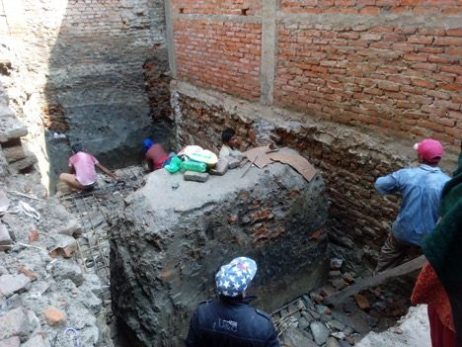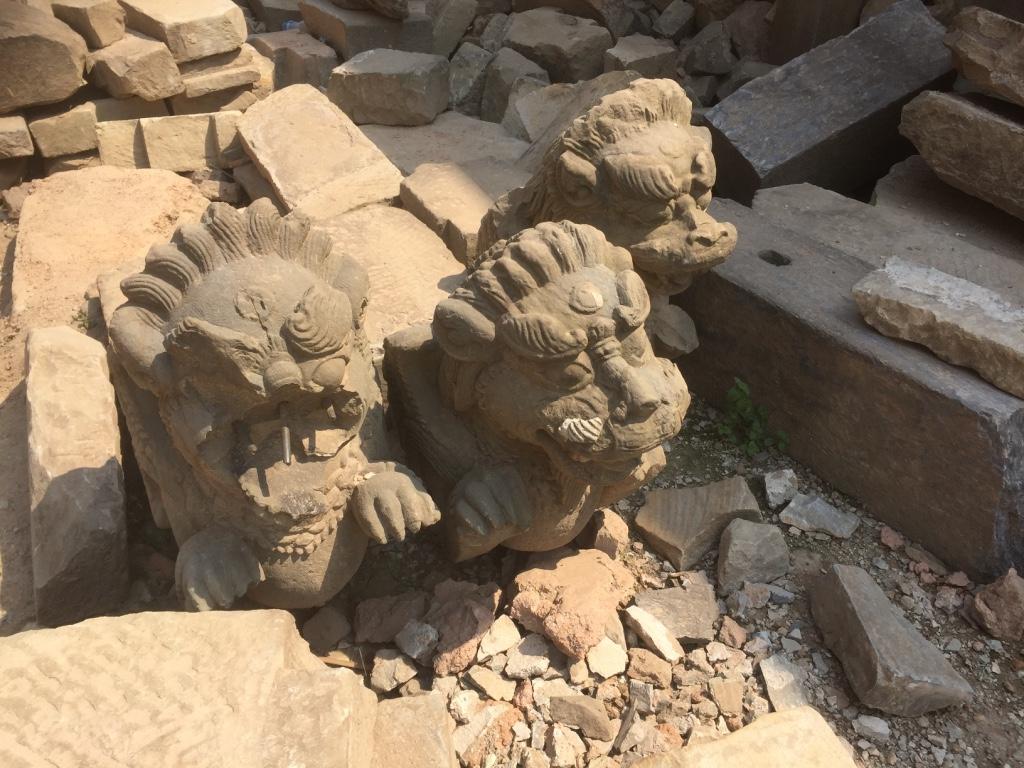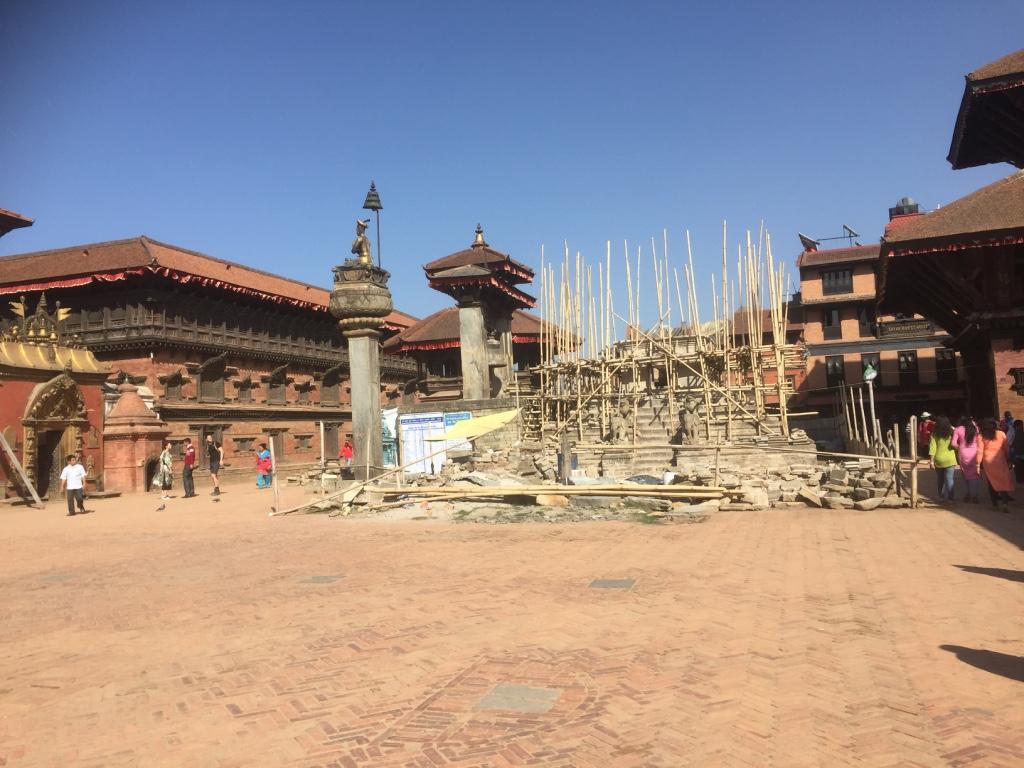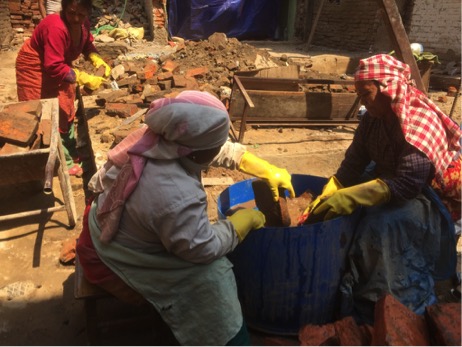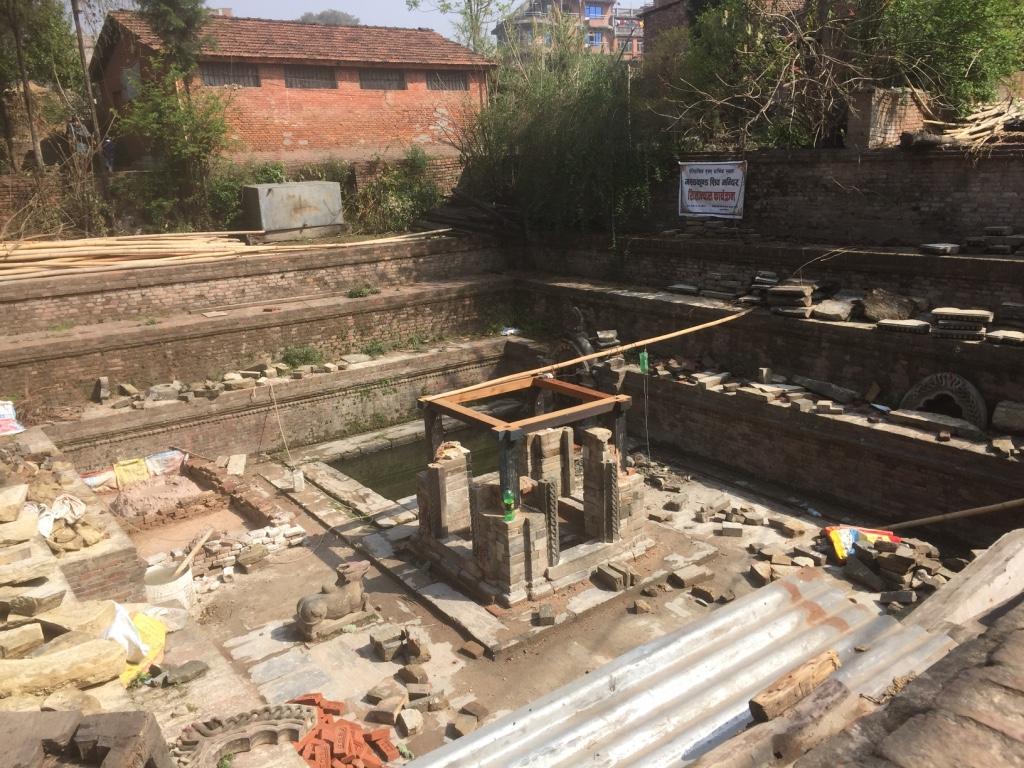Photo Collection
New! We are pleased to announce that our fieldwork photo collection of 216 images has now been published by UBC cIRcle, an open-access digital repository for research and teaching materials. The full collection can be viewed here.
This photo collection is a compilation of images taken by members of the Social Science Baha research team located in Kathmandu, Nepal. The pictures were taken while conducting fieldwork between 2018-2019 for the SSHRC Partnership Development Grant: ‘Expertise, Labour and Mobility in Nepal’s Post-Conflict, Post-Disaster Reconstruction.’
The images portray community members’ experiences following the earthquakes of 2015 in three regions of Nepal: Bhaktapur, Kathmandu Valley; Borang, Dhading; Kartike, Sindhupalchowk. Although each location felt the effects of the earthquakes very differently, overarching issues such as access to construction materials and government funding, adherence to strict building codes, availability of skilled and unskilled labourers, and the sustainability of local forms of knowledge are seen across each site. These issues provide a pathway for understanding the complexities and contradictions present in Nepal’s ongoing reconstruction.
A selection of photos from the full collection can be found below.
Please direct any questions or comments to: nepal.reconstruction@ubc.ca.
Bhaktapur, Kathmandu Valley
Borang, Dhading
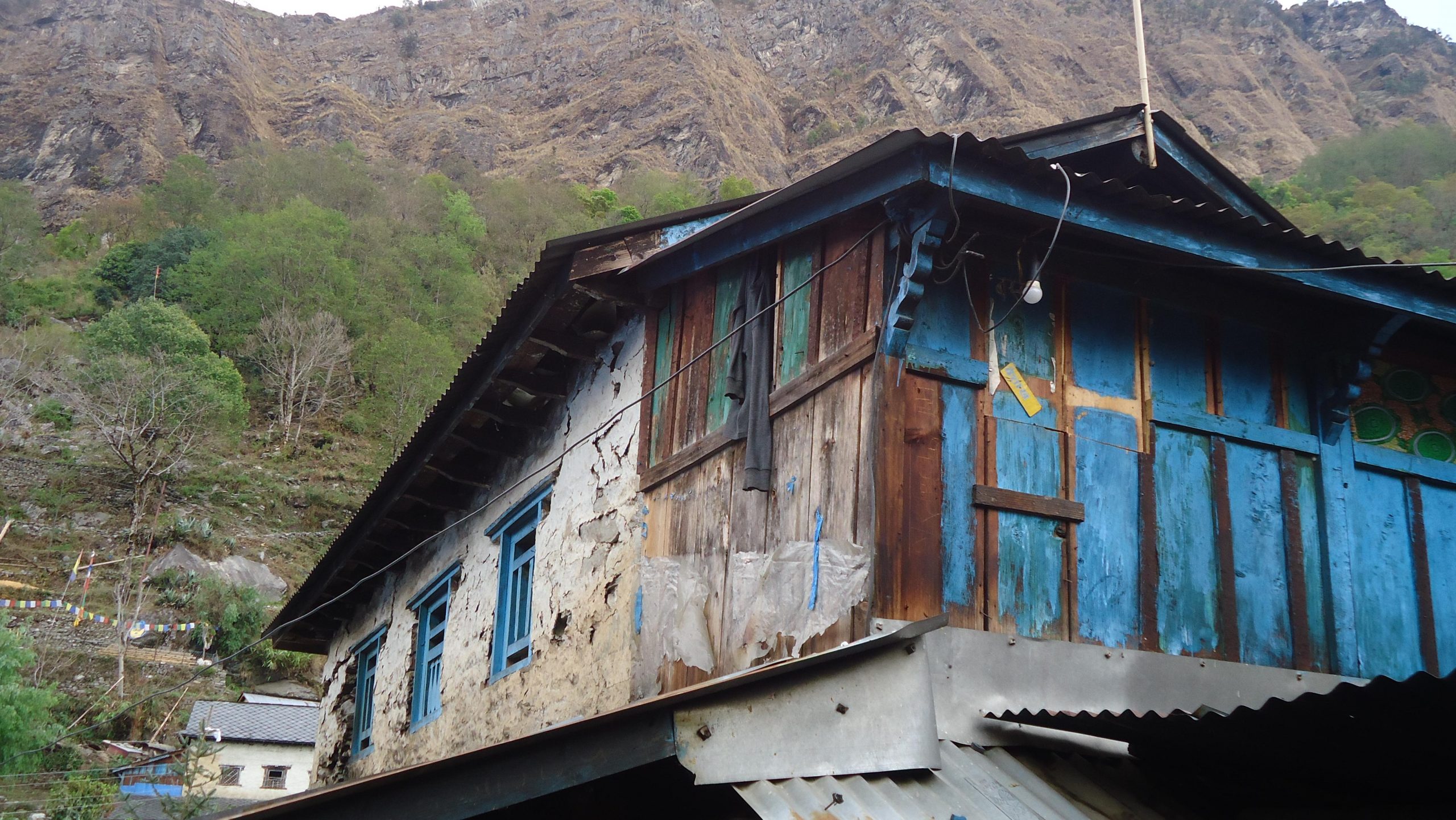 © Manoj Suji. Many of the new houses following the government-approved earthquake resistant designs issued after the 2015 earthquake do not incorporate many of the traditional features of the old houses. This house is not only fairly large for the village, but also has traditional design elements such as two-and-half storey construction, extended verandah as a separate room, and carved wooden struts. © Manoj Suji. Many of the new houses following the government-approved earthquake resistant designs issued after the 2015 earthquake do not incorporate many of the traditional features of the old houses. This house is not only fairly large for the village, but also has traditional design elements such as two-and-half storey construction, extended verandah as a separate room, and carved wooden struts. |
 © Manoj Suji. Many women masons have been trained to fill the gap left by the out-migration of men and a scarcity of skilled masons during the reconstruction process following the 2015 earthquake. © Manoj Suji. Many women masons have been trained to fill the gap left by the out-migration of men and a scarcity of skilled masons during the reconstruction process following the 2015 earthquake. |
 © Manoj Suji. This house has been built almost entirely out of wooden planks, except for the roof. While not promoted by the government during the post 2015 earthquake reconstruction effort and socially seen a sign of poverty, these structures are thought to be more resilient during earthquakes and cause less damage when they topple. © Manoj Suji. This house has been built almost entirely out of wooden planks, except for the roof. While not promoted by the government during the post 2015 earthquake reconstruction effort and socially seen a sign of poverty, these structures are thought to be more resilient during earthquakes and cause less damage when they topple. |
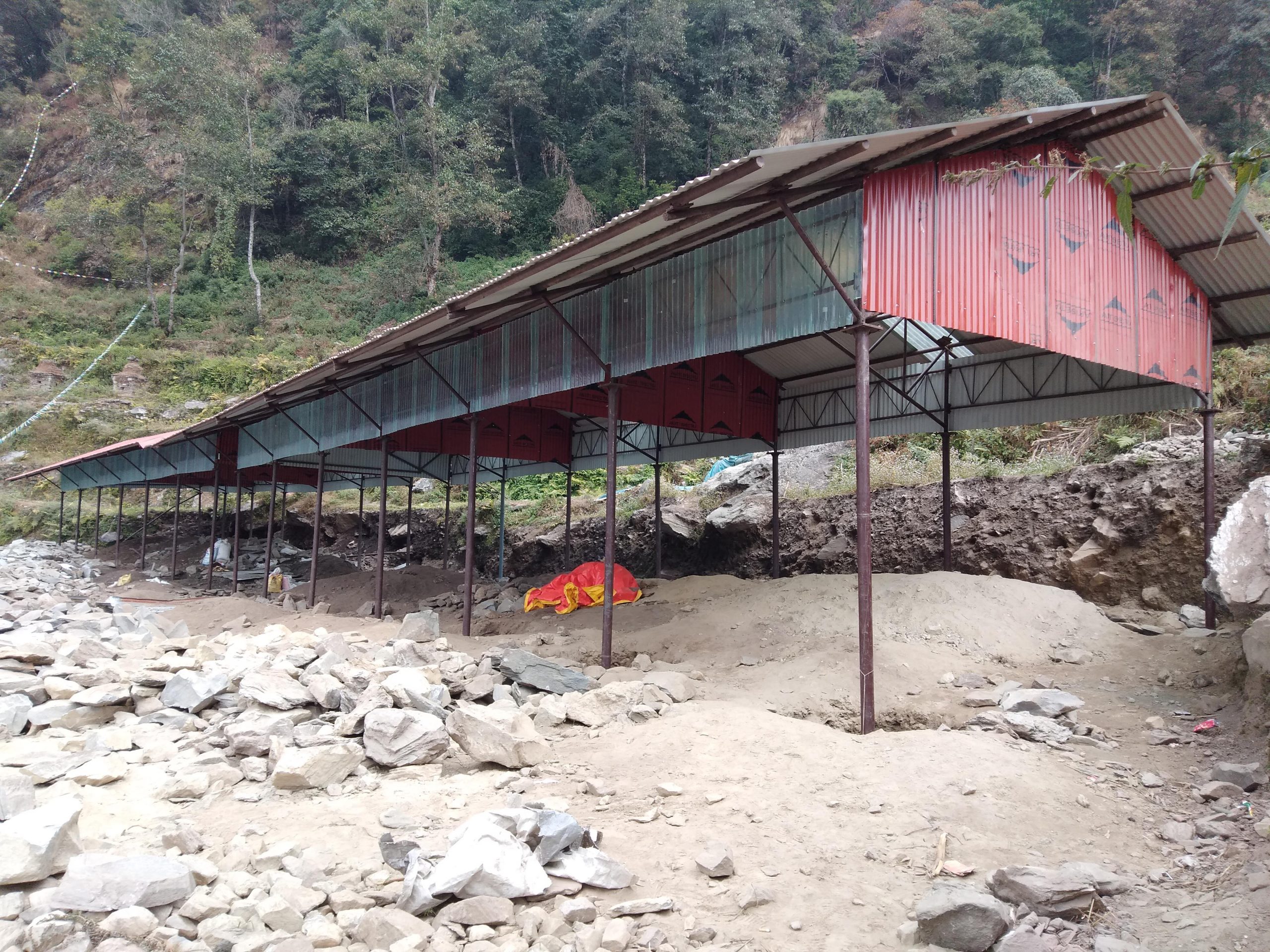 © Manoj Suji. Utilisation of iron trusses and iron pipes makes the construction process quick and easy, although their cost is high and transportation to rural areas is challenging. Mukrap Devi Higher Secondary School in Borang was being reconstructed utilising such trusses. The school reconstruction was financed by the United Mission to Nepal (UMN) and facilitated by Himalayan Community Salvation Society (HIMS-Nepal). © Manoj Suji. Utilisation of iron trusses and iron pipes makes the construction process quick and easy, although their cost is high and transportation to rural areas is challenging. Mukrap Devi Higher Secondary School in Borang was being reconstructed utilising such trusses. The school reconstruction was financed by the United Mission to Nepal (UMN) and facilitated by Himalayan Community Salvation Society (HIMS-Nepal). |
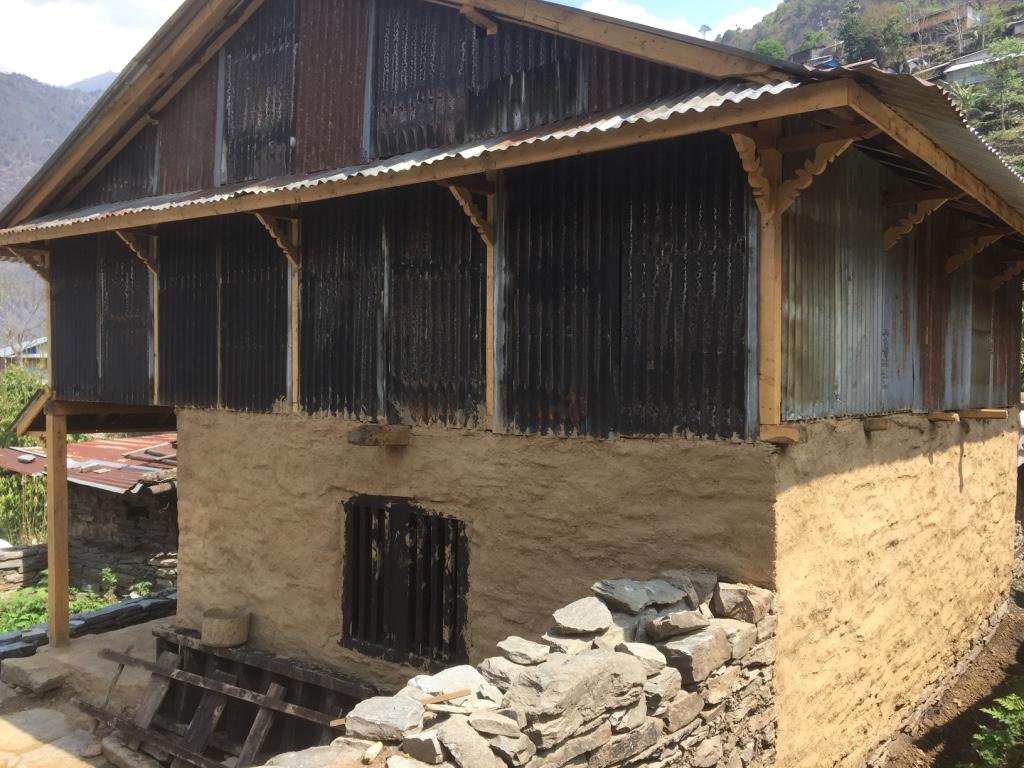 © Bina Limbu. Most of the government-approved designs call for one-storey houses or more stringent design measures in response to the widespread destruction of the 2015 earthquake. People however add additional floors utilising timber or corrugated iron sheets, as in this case, to create additional much needed space. © Bina Limbu. Most of the government-approved designs call for one-storey houses or more stringent design measures in response to the widespread destruction of the 2015 earthquake. People however add additional floors utilising timber or corrugated iron sheets, as in this case, to create additional much needed space. |
 © Manoj Suji. Along with introduction of chainsaws, electric sawmills have been established during the post-earthquake reconstruction to cater to increased demands for planks and boards. © Manoj Suji. Along with introduction of chainsaws, electric sawmills have been established during the post-earthquake reconstruction to cater to increased demands for planks and boards. |
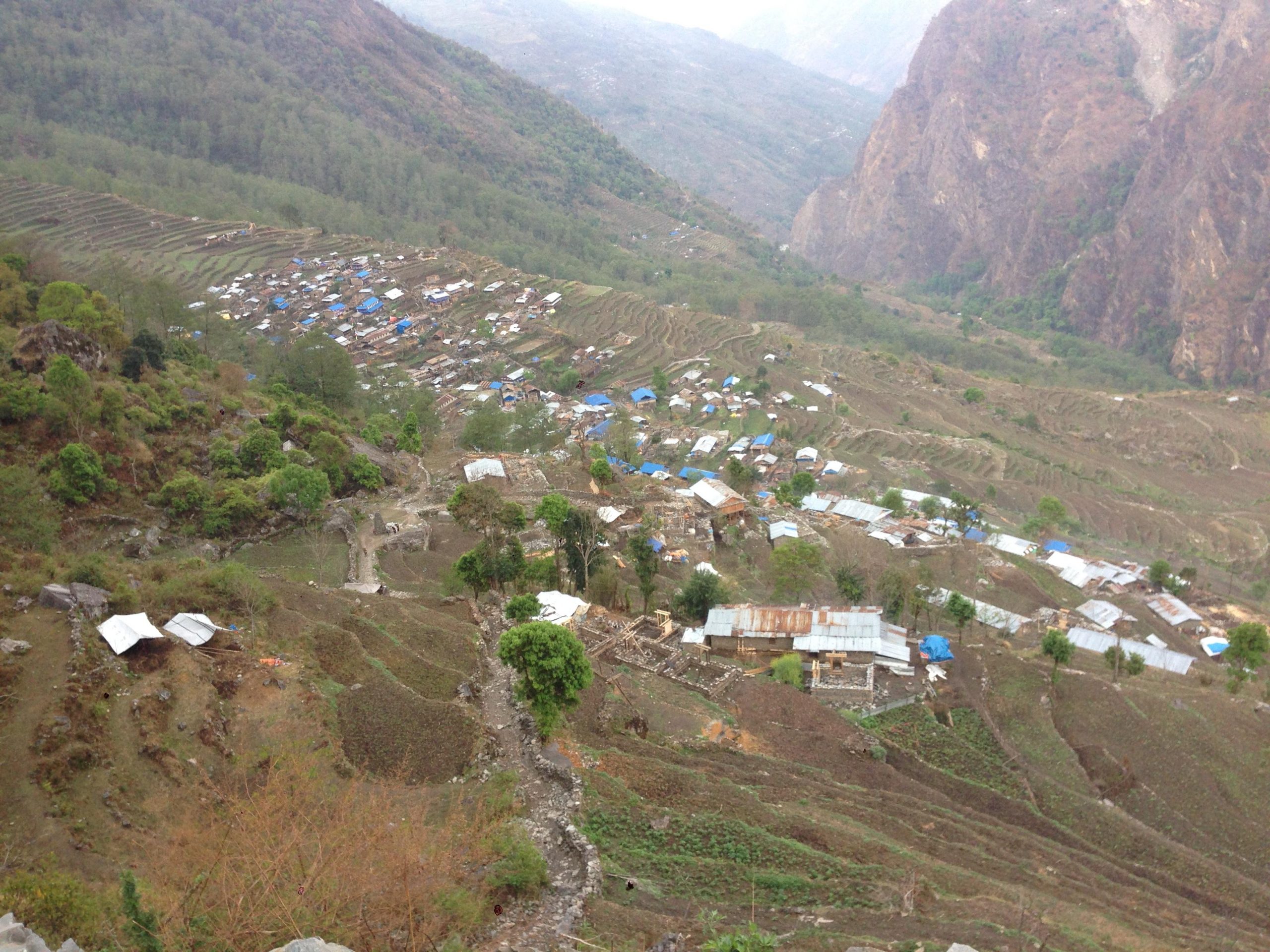 © Prakash Chandra Subedi. Houses are normally clustered in the mid-hills. Note the roofs of houses that have been recently built using corrugated iron sheets. © Prakash Chandra Subedi. Houses are normally clustered in the mid-hills. Note the roofs of houses that have been recently built using corrugated iron sheets. |
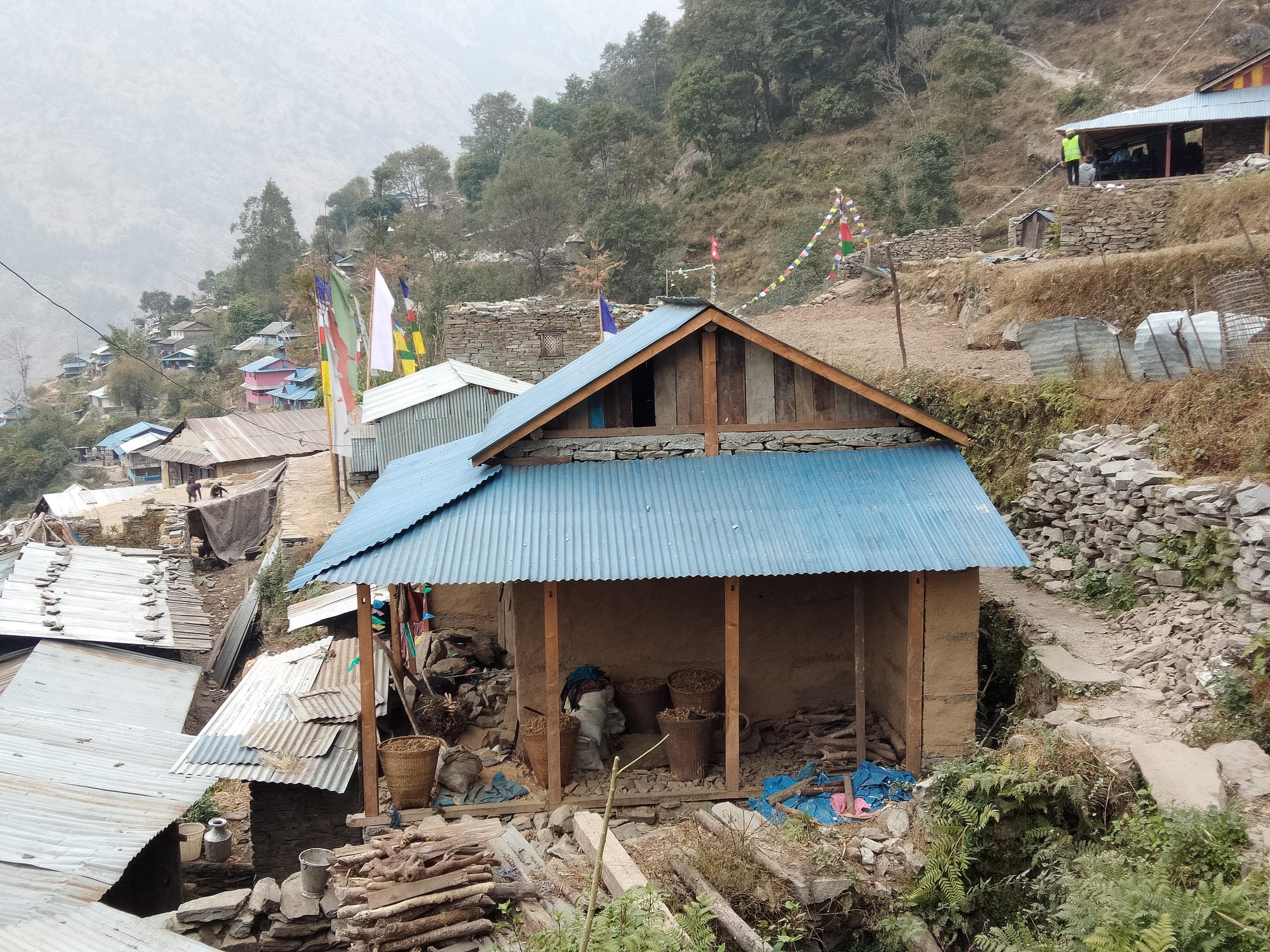 © Manoj Suji. Agricultural people in rural Nepal need a large amount of space for the storage of food, fodder, and other essentials. This need has not been taken into account in the government-approved house designs disseminated after the 2015 earthquake. In this photo, the family has added a verandah where harvested millets in doko (traditional bamboo baskets) are kept to help address their storage needs. © Manoj Suji. Agricultural people in rural Nepal need a large amount of space for the storage of food, fodder, and other essentials. This need has not been taken into account in the government-approved house designs disseminated after the 2015 earthquake. In this photo, the family has added a verandah where harvested millets in doko (traditional bamboo baskets) are kept to help address their storage needs. |
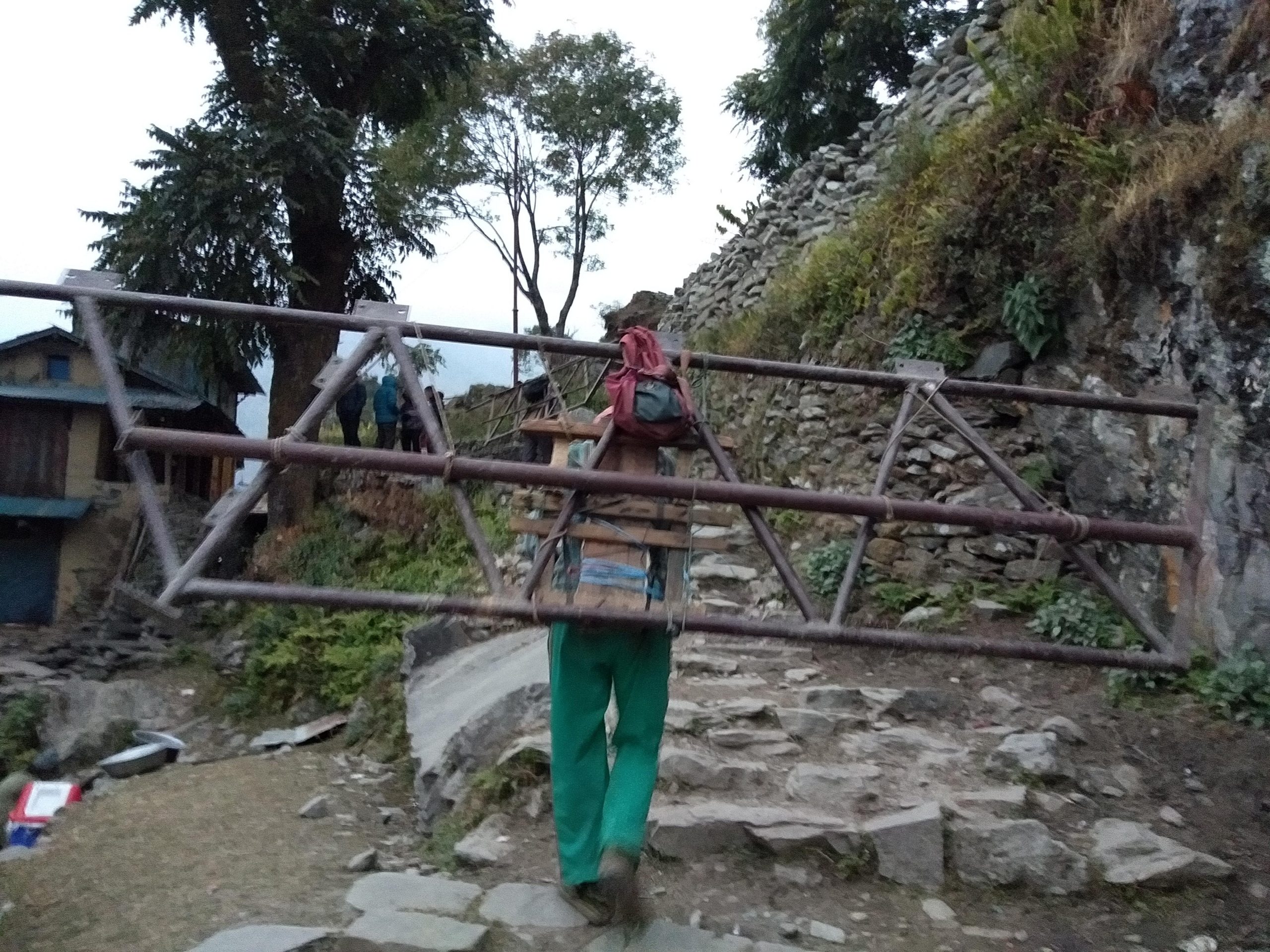 © Manoj Suji. It is challenging to transport irregular and large construction materials in the narrow trails and paths in the mid-hills. Bringing in materials from markets to rural towns was common during the post-earthquake reconstruction. © Manoj Suji. It is challenging to transport irregular and large construction materials in the narrow trails and paths in the mid-hills. Bringing in materials from markets to rural towns was common during the post-earthquake reconstruction. |
 © Bina Limbu. Stones are important building materials in rural areas. However, the availability and quality of stones often requires skilled masons to work on them. © Bina Limbu. Stones are important building materials in rural areas. However, the availability and quality of stones often requires skilled masons to work on them. |
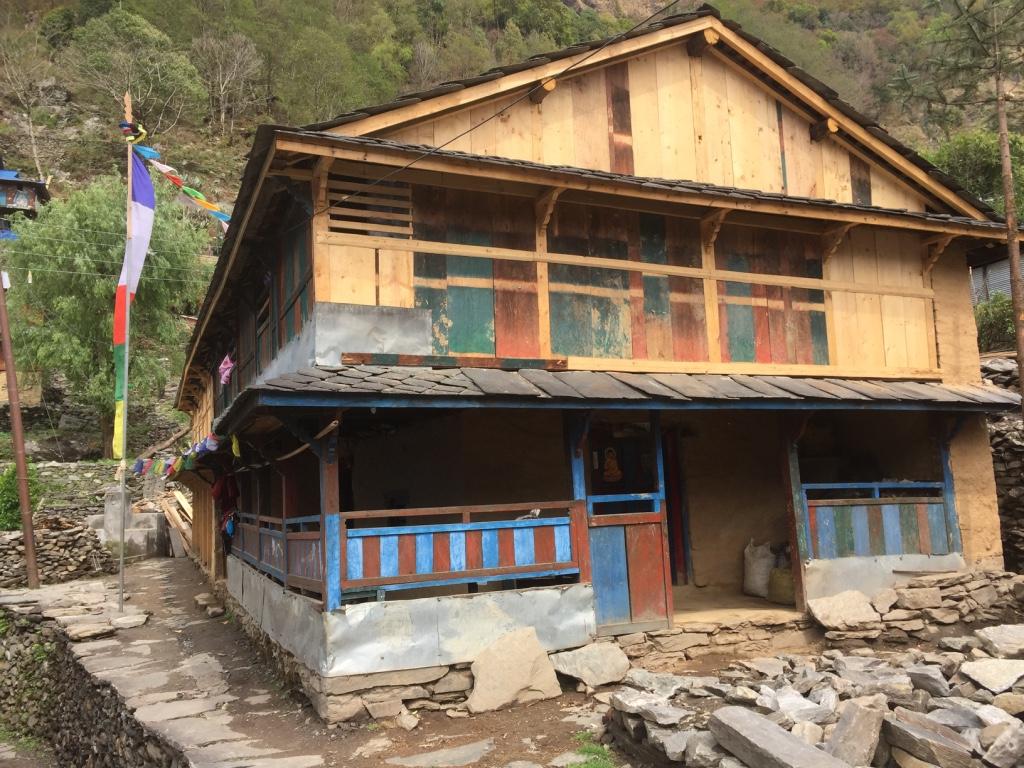 © Bina Limbu. This house appears to have been reconstructed using timber reused from old buildings. However, this does not seem to have followed building codes which discourage tall buildings without proper, earthquake resistant design. © Bina Limbu. This house appears to have been reconstructed using timber reused from old buildings. However, this does not seem to have followed building codes which discourage tall buildings without proper, earthquake resistant design. |
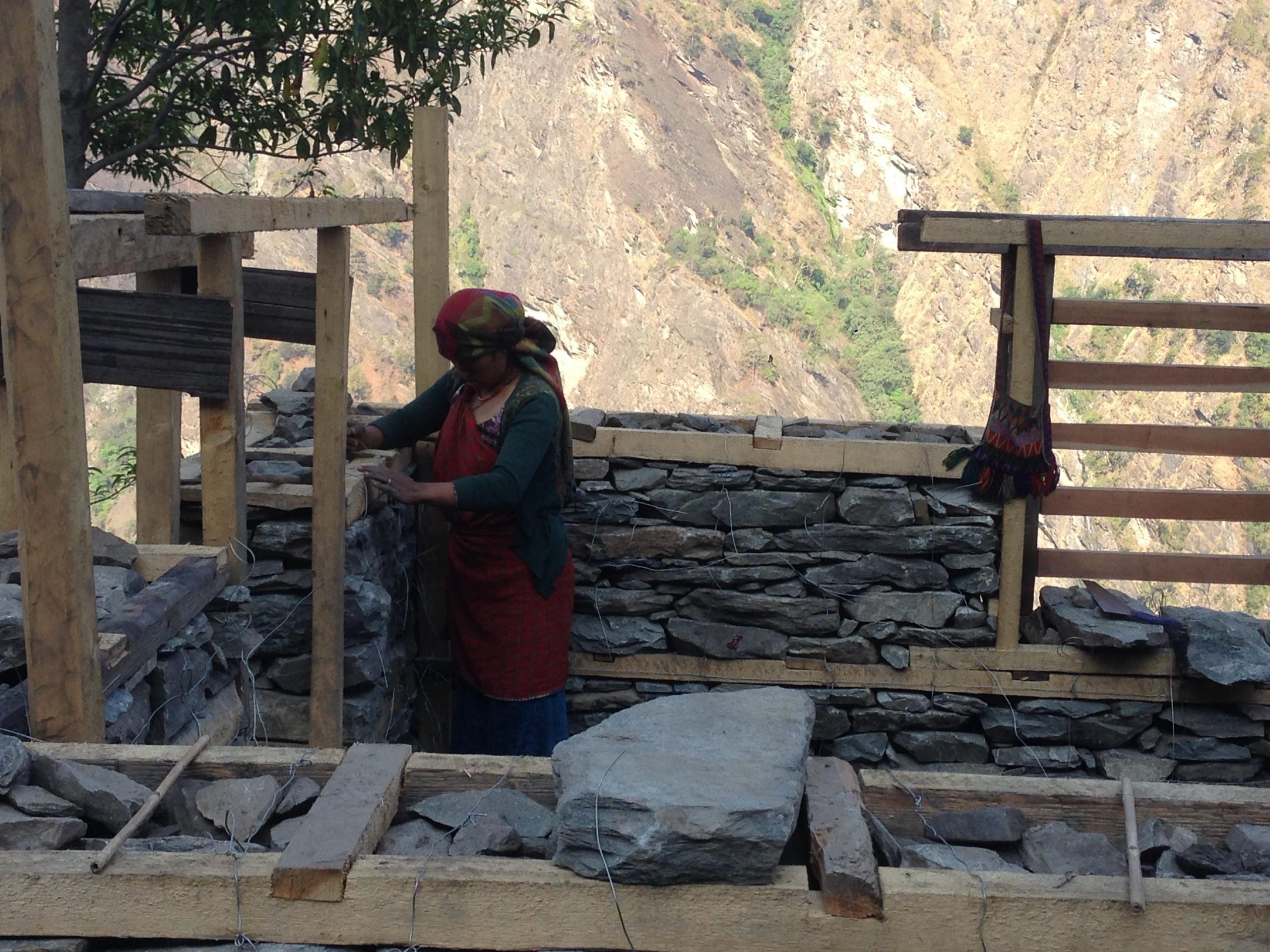 © Prakash Chandra Subedi. Trained women masons have been filling the need for masons in the reconstruction process following the 2015 earthquake. © Prakash Chandra Subedi. Trained women masons have been filling the need for masons in the reconstruction process following the 2015 earthquake. |
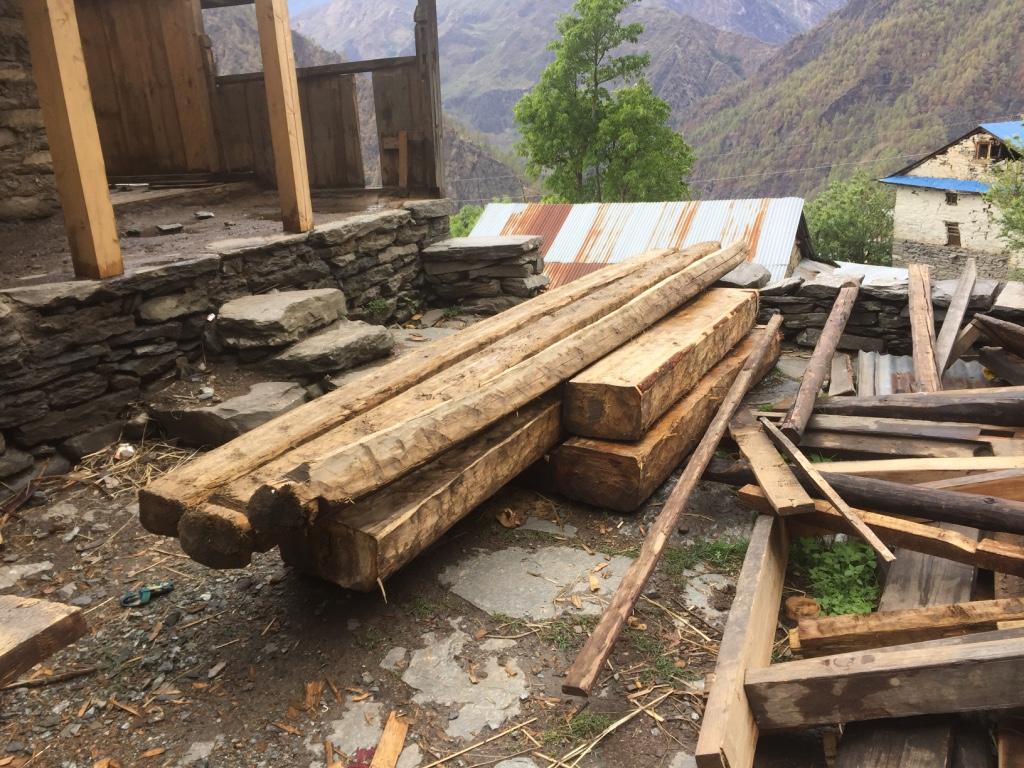 © Bina Limbu. Timber is still widely used in house reconstruction in rural areas after the 2015 earthquake, as many families can harvest it from their own land or easily obtain it locally. © Bina Limbu. Timber is still widely used in house reconstruction in rural areas after the 2015 earthquake, as many families can harvest it from their own land or easily obtain it locally. |
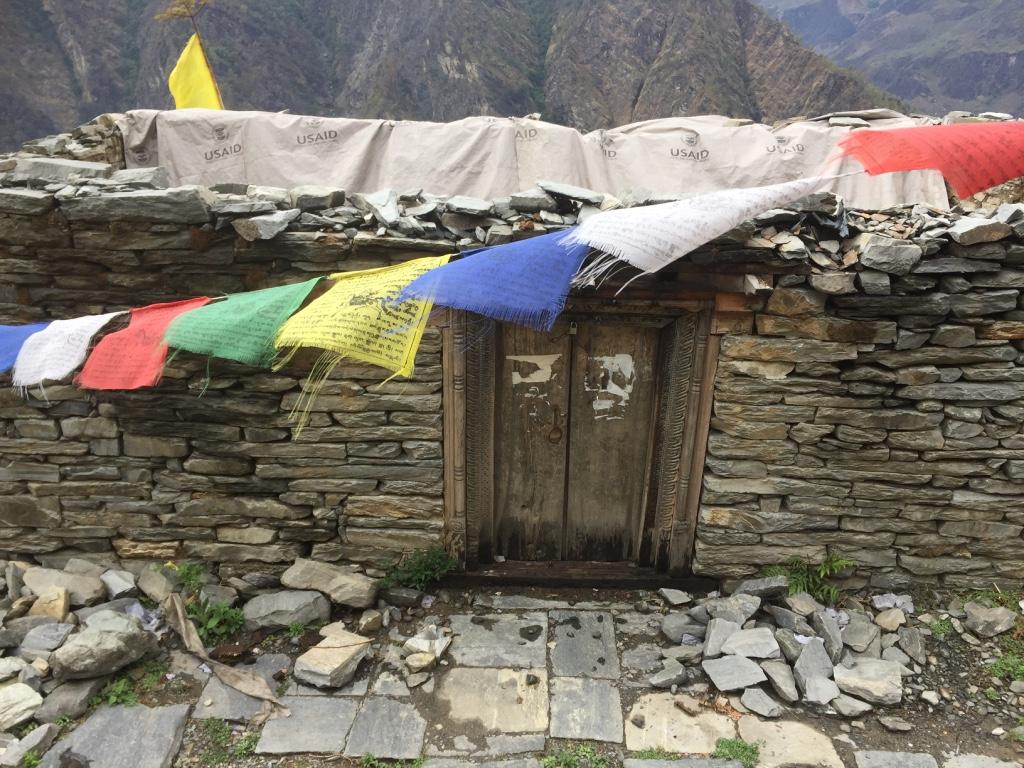 © Bina Limbu. Along with many residential buildings, houses of worship were also destroyed during the earthquake. People of Borang used to perform their worships and rituals in the only gumba in the village, which got destroyed in the earthquake. The plans to rebuild this local gumba has been inconclusive due to the lack of funding. Here, the priests and the locals have covered the masonry walls with donated tarpaulins. © Bina Limbu. Along with many residential buildings, houses of worship were also destroyed during the earthquake. People of Borang used to perform their worships and rituals in the only gumba in the village, which got destroyed in the earthquake. The plans to rebuild this local gumba has been inconclusive due to the lack of funding. Here, the priests and the locals have covered the masonry walls with donated tarpaulins. |
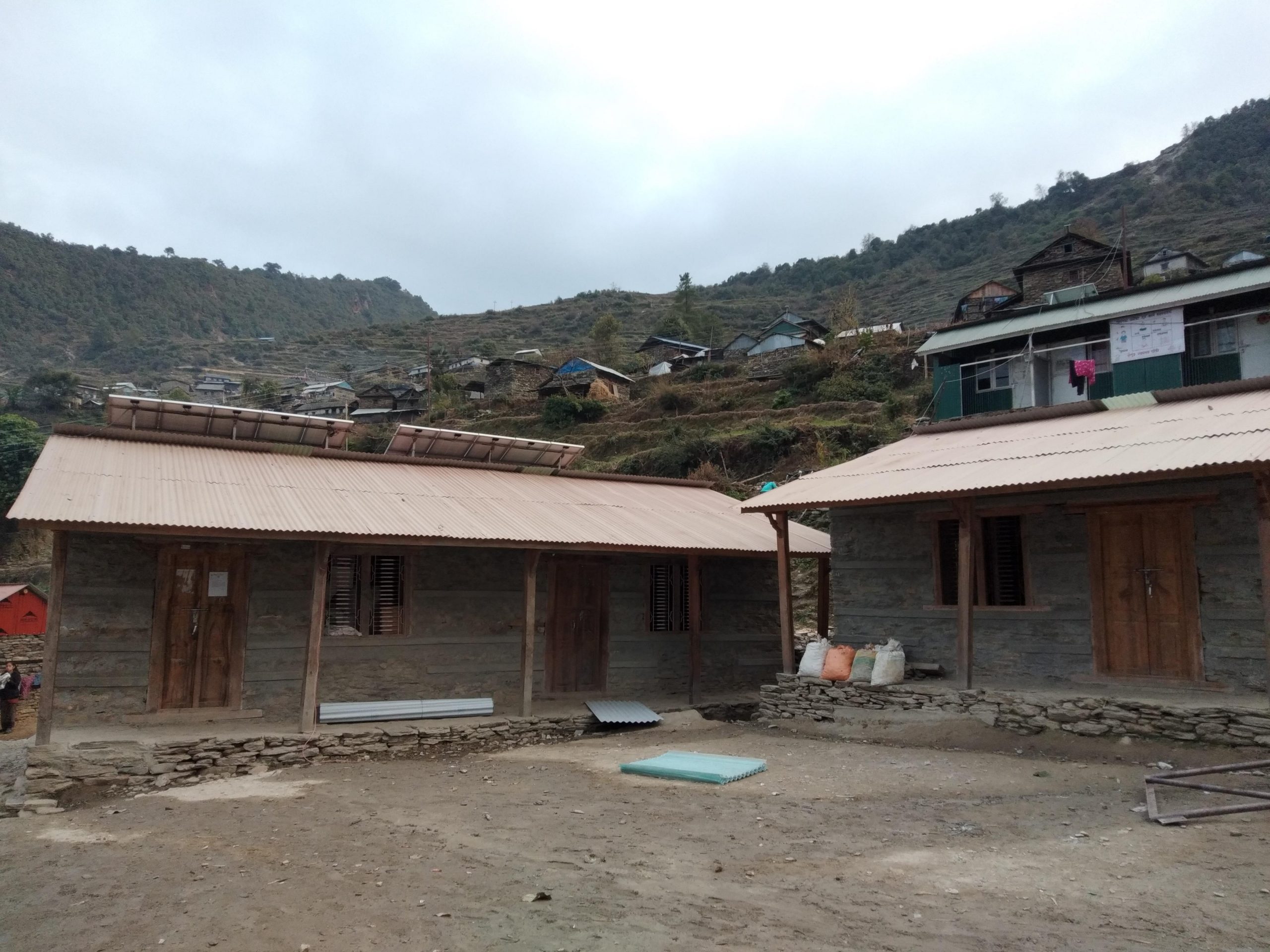 © Manoj Suji. Schools that were rebuilt after the 2015 earthquake have many amenities such as larger windows, solar-powered lighting, and toilets. © Manoj Suji. Schools that were rebuilt after the 2015 earthquake have many amenities such as larger windows, solar-powered lighting, and toilets. |
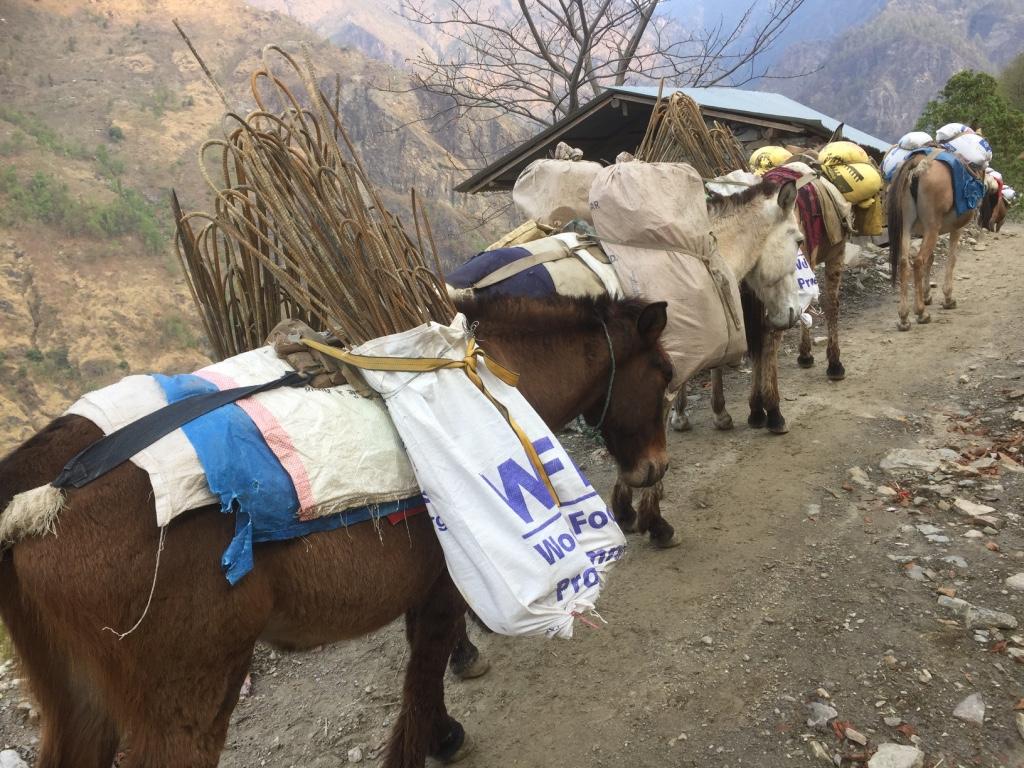 © Bina Limbu. Transporting construction materials such as cement and iron rods to rural areas is challenging, and the mode of transportation takes many forms. Here, mules are carrying iron rods in sacks donated by the World Food Programme (WFP). © Bina Limbu. Transporting construction materials such as cement and iron rods to rural areas is challenging, and the mode of transportation takes many forms. Here, mules are carrying iron rods in sacks donated by the World Food Programme (WFP). |
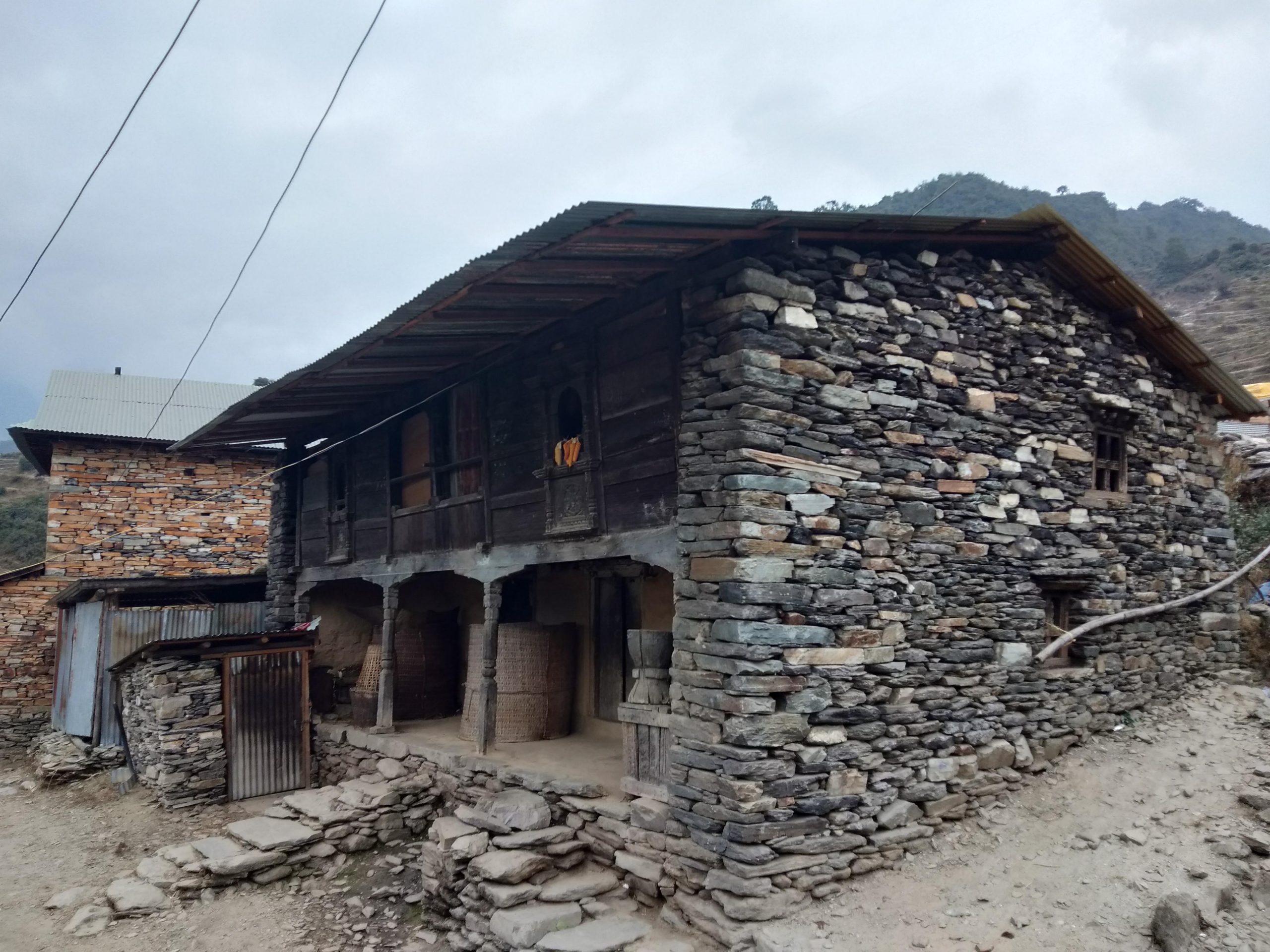 © Manoj Suji. It is easier (re)roof traditional houses with corrugated sheets as they are convenient and quick to build with, although they make the house stuffy during the day and cold at night. Following the 2015 earthquake many houses chose to use corrugated sheets instead of traditional tiles due to that convenience. © Manoj Suji. It is easier (re)roof traditional houses with corrugated sheets as they are convenient and quick to build with, although they make the house stuffy during the day and cold at night. Following the 2015 earthquake many houses chose to use corrugated sheets instead of traditional tiles due to that convenience. |
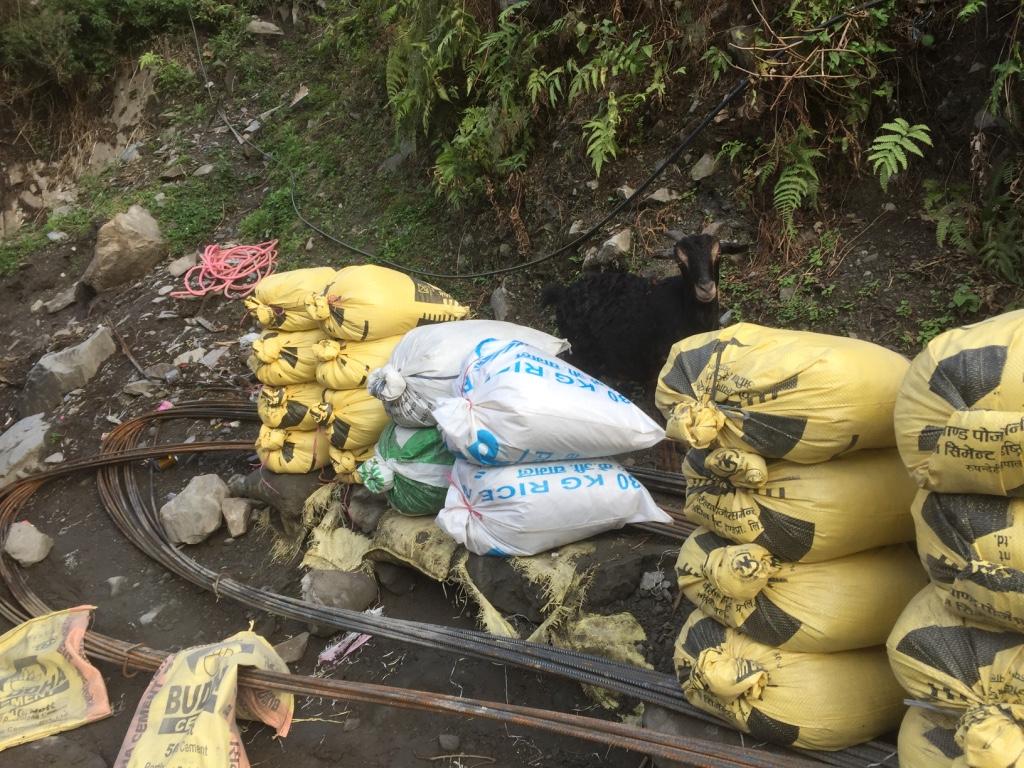 © Bina Limbu. Reinforced concrete structures were better able to withstand the earthquake tremors of 2015 and many of them survived. This has prompted many people in rural areas to utilize these expensive, difficult-to-procure, and difficult-to-transport materials for the reconstruction of their houses. © Bina Limbu. Reinforced concrete structures were better able to withstand the earthquake tremors of 2015 and many of them survived. This has prompted many people in rural areas to utilize these expensive, difficult-to-procure, and difficult-to-transport materials for the reconstruction of their houses. |
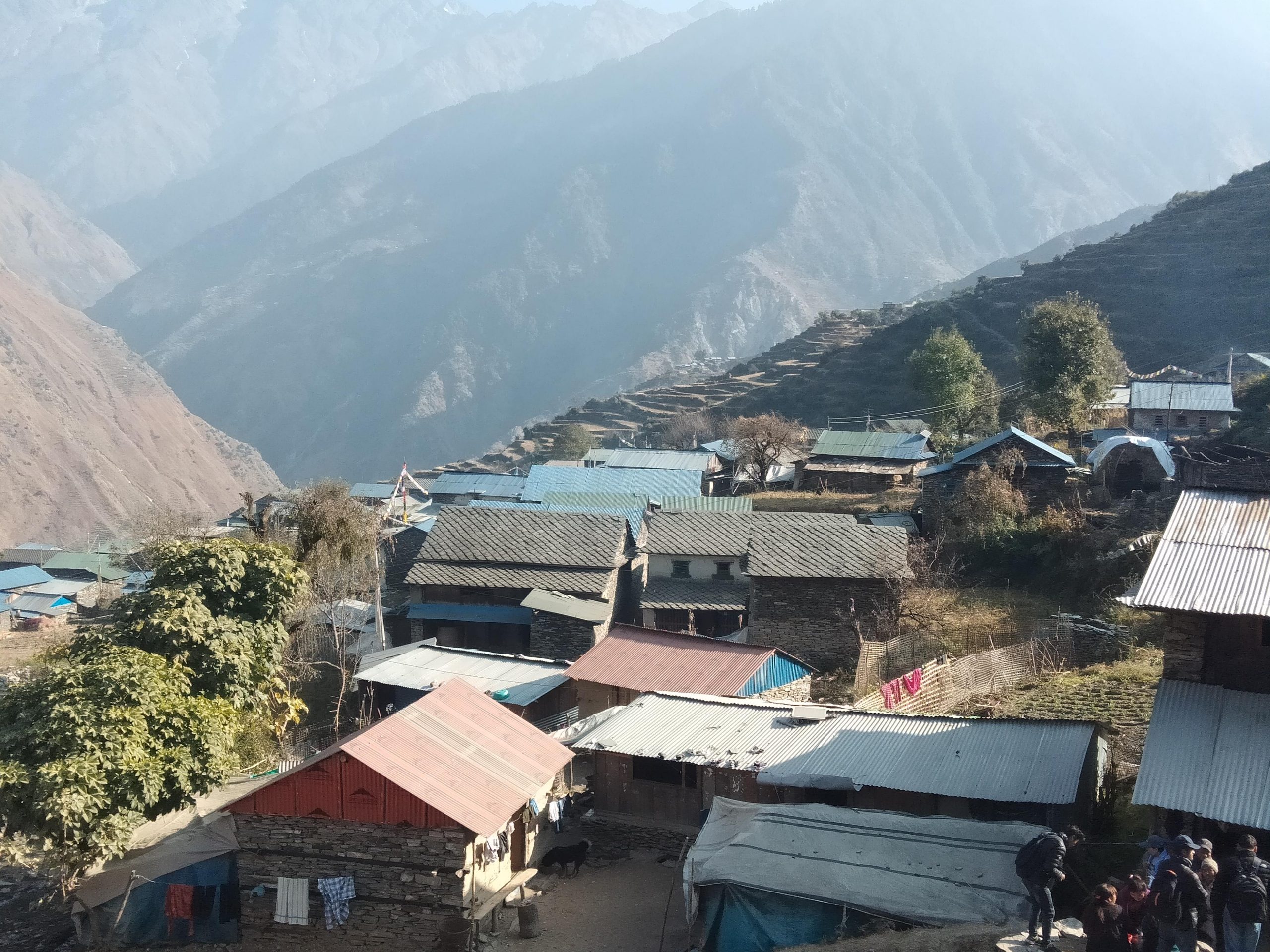 © Manoj Suji. The village of Borang traditionally used slates for roofing, but it is a slow and expensive process compared to using the corrugated sheets carried in from the markets, which make roofing quicker and convenient. © Manoj Suji. The village of Borang traditionally used slates for roofing, but it is a slow and expensive process compared to using the corrugated sheets carried in from the markets, which make roofing quicker and convenient. |
 © Manoj Suji. Materials donated or introduced immediately after the 2015 earthquake for the purposes of temporary shelter have found second life in a variety of uses in rural settlements, such as the use of this tarpaulin as a cover for grain. © Manoj Suji. Materials donated or introduced immediately after the 2015 earthquake for the purposes of temporary shelter have found second life in a variety of uses in rural settlements, such as the use of this tarpaulin as a cover for grain. |
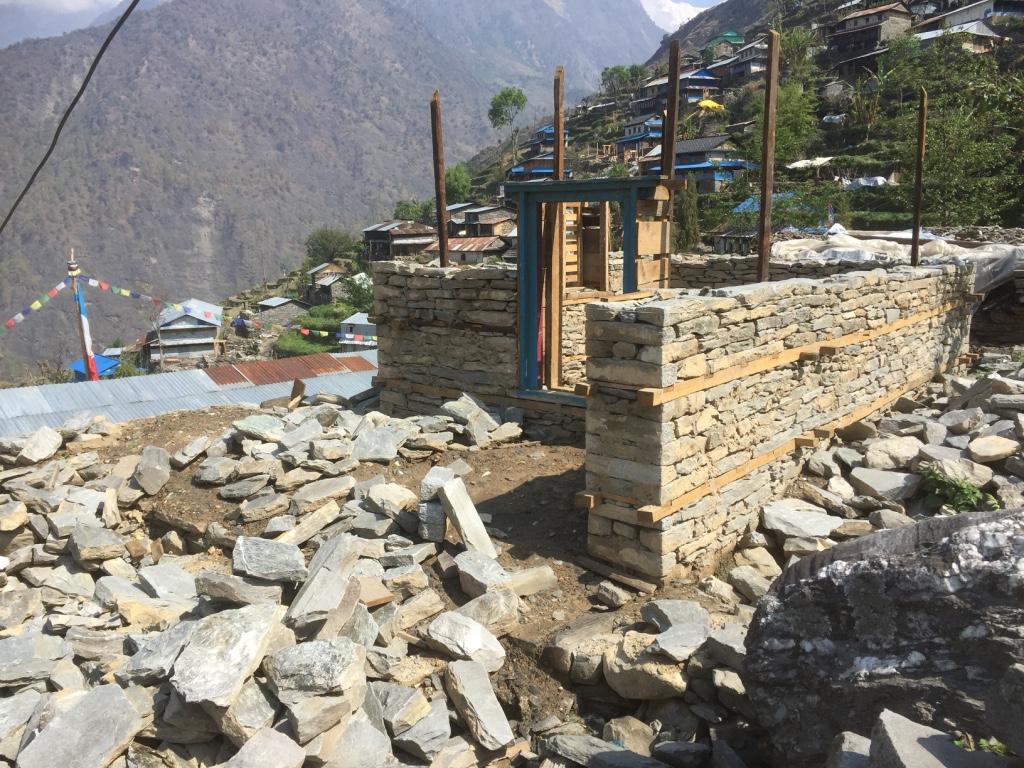 © Bina Limbu. Masonry walls are the norm in most rural areas for building construction. Horizontal bands have started to be incorporated in the new houses as part of the earthquake resistant design techniques that became more widespread following the 2015 earthquake. © Bina Limbu. Masonry walls are the norm in most rural areas for building construction. Horizontal bands have started to be incorporated in the new houses as part of the earthquake resistant design techniques that became more widespread following the 2015 earthquake. |
Kartike, Sindhupalchowk
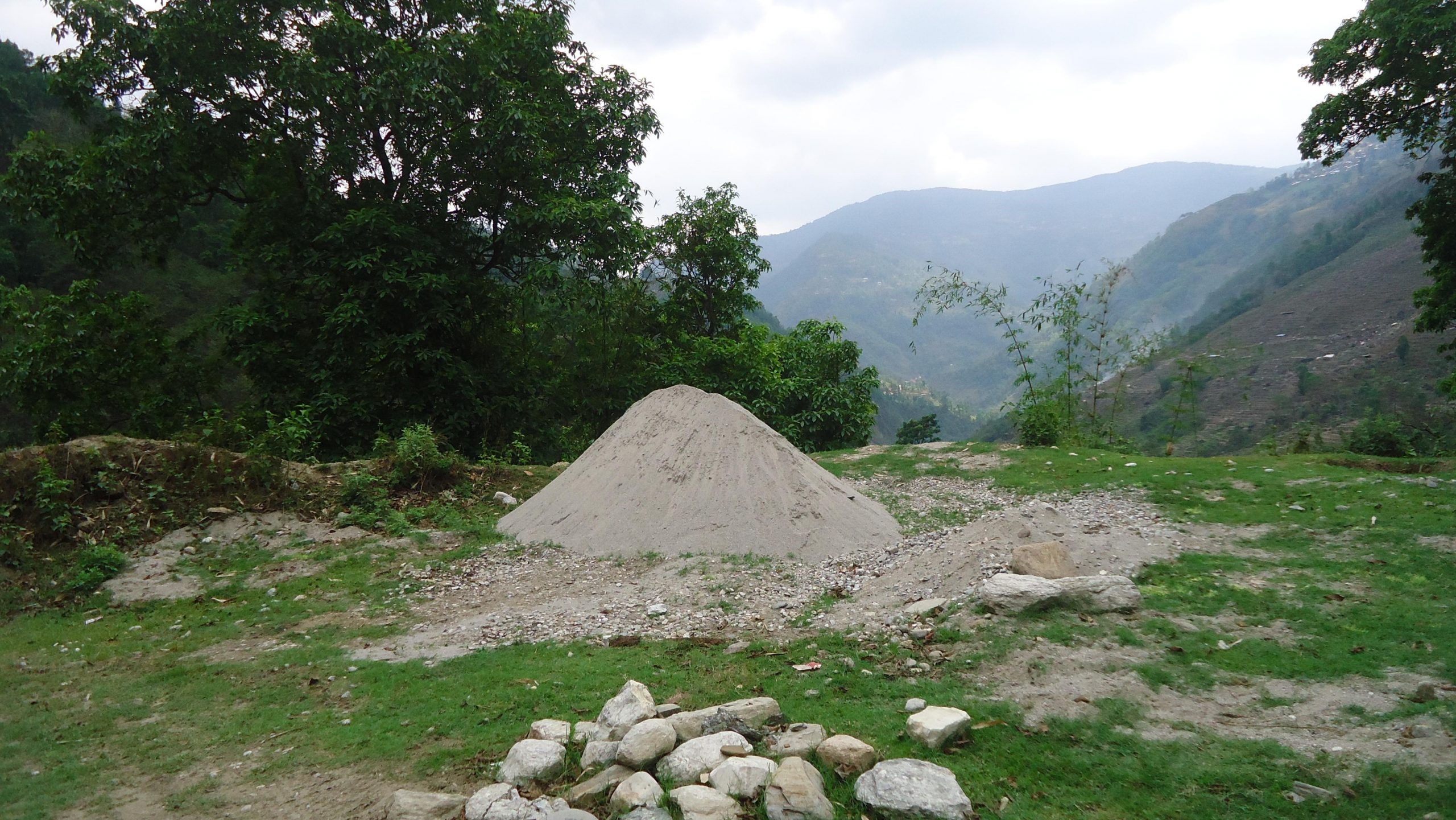 © Manoj Suji. Although there has been increased usage of reinforced concrete in reconstruction after the 2015 earthquake, the cost of acquiring and transporting building materials like sand and other aggregates that are located far away from the rural settlements in the hills can be expensive. There is also a natural limit to the amount of aggregate that can be mined in the rivers and quarries. © Manoj Suji. Although there has been increased usage of reinforced concrete in reconstruction after the 2015 earthquake, the cost of acquiring and transporting building materials like sand and other aggregates that are located far away from the rural settlements in the hills can be expensive. There is also a natural limit to the amount of aggregate that can be mined in the rivers and quarries. |
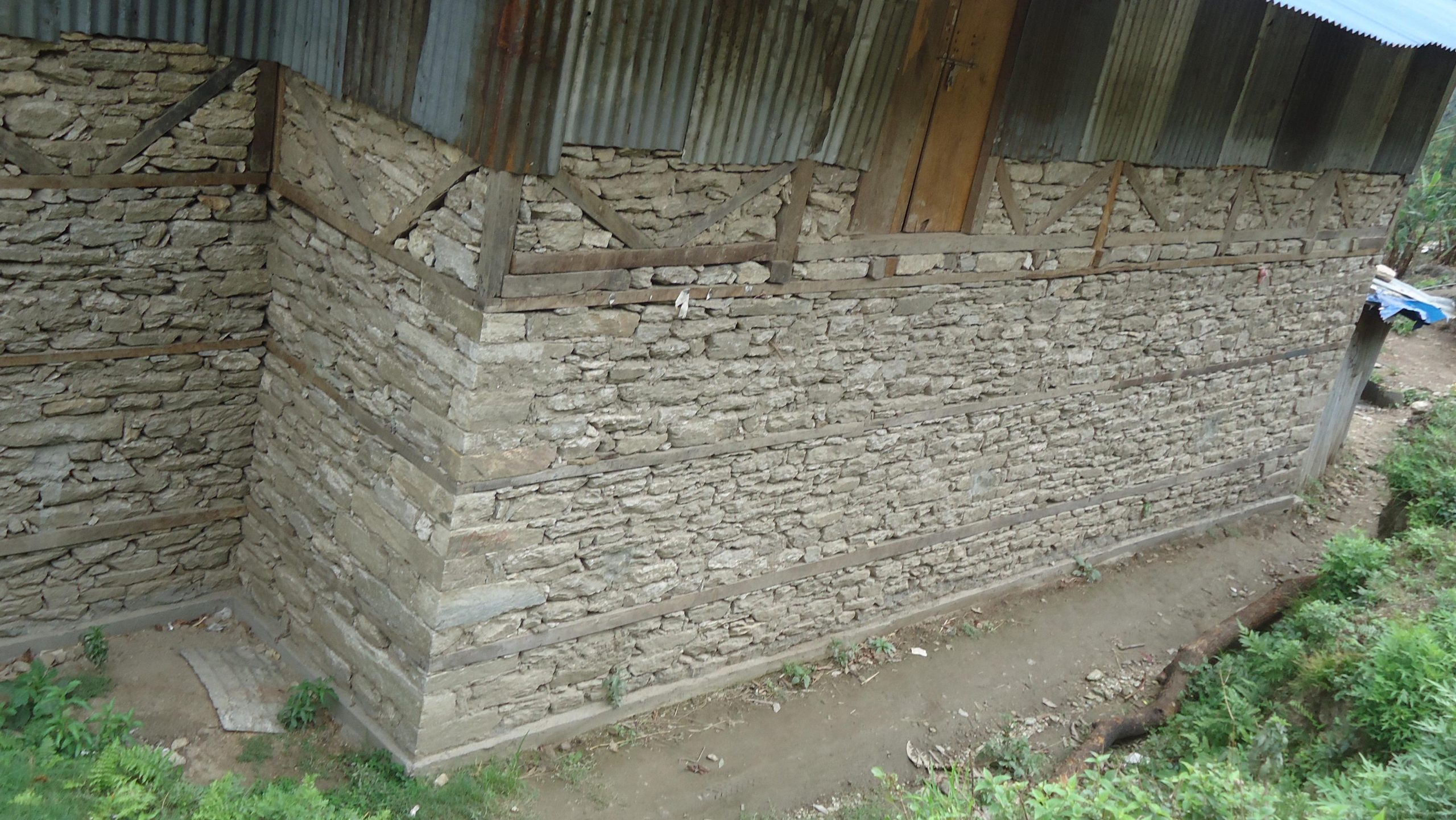 © Manoj Suji. Along with access to materials and their cost, workmanship has also been a huge part of the discussion during the reconstruction phase after the 2015 earthquake. Without following proper construction techniques, even reinforced concrete structures, which are widely seen as being more earthquake resistant, would not be stronger than any others. Here in this photo, the cornerstones have been placed tightly in alignment and the horizontal and other bands have been utilised as well, indicating skilled construction work. © Manoj Suji. Along with access to materials and their cost, workmanship has also been a huge part of the discussion during the reconstruction phase after the 2015 earthquake. Without following proper construction techniques, even reinforced concrete structures, which are widely seen as being more earthquake resistant, would not be stronger than any others. Here in this photo, the cornerstones have been placed tightly in alignment and the horizontal and other bands have been utilised as well, indicating skilled construction work. |
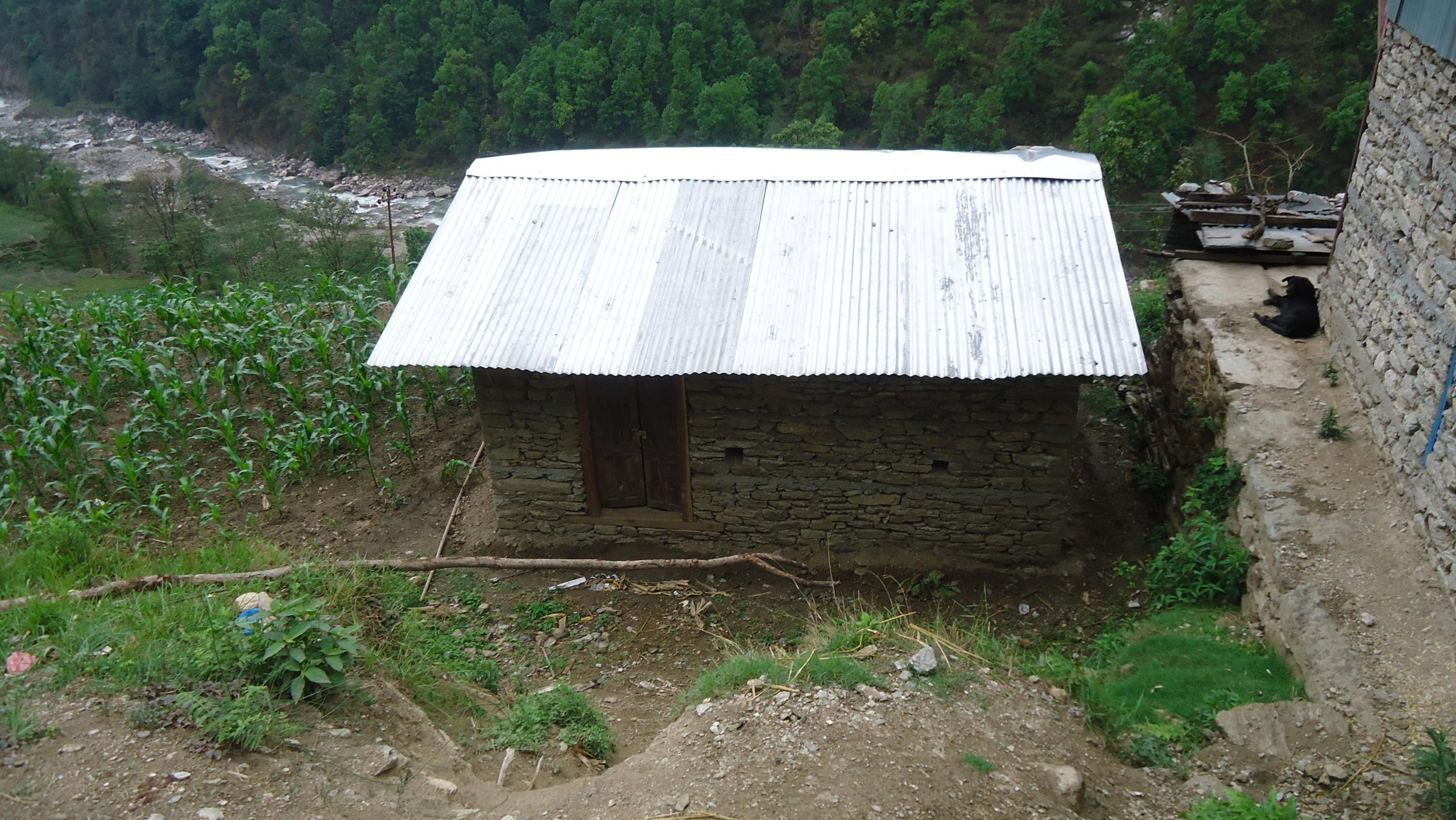 © Manoj Suji. During the reconstruction period following the 2015 earthquake, many people built one-room houses in order to access government grants, which were distributed upon reaching certain construction milestones. These one-room houses obviously do not meet the needs of the families, and will also further contribute to their debt when they do eventually build a house more suited to their needs. There were several other factors leading to the abundance of this type of house however, including an overwhelming emphasis on building houses based on the templates designed in the centrally located Kathmandu, failure of the government to inform people of new engineering practices, and insufficient grants to build a proper house. © Manoj Suji. During the reconstruction period following the 2015 earthquake, many people built one-room houses in order to access government grants, which were distributed upon reaching certain construction milestones. These one-room houses obviously do not meet the needs of the families, and will also further contribute to their debt when they do eventually build a house more suited to their needs. There were several other factors leading to the abundance of this type of house however, including an overwhelming emphasis on building houses based on the templates designed in the centrally located Kathmandu, failure of the government to inform people of new engineering practices, and insufficient grants to build a proper house. |
 © Bina Limbu. The use of reinforced concrete for house construction in rural areas has increased during post-earthquake reconstruction. As many of these affected settlements are located in high hills away from markets, where cement and iron rods are procured, and riverbeds, from where sand and stones are mined, transporting these materials has become a challenge to these places. © Bina Limbu. The use of reinforced concrete for house construction in rural areas has increased during post-earthquake reconstruction. As many of these affected settlements are located in high hills away from markets, where cement and iron rods are procured, and riverbeds, from where sand and stones are mined, transporting these materials has become a challenge to these places. |
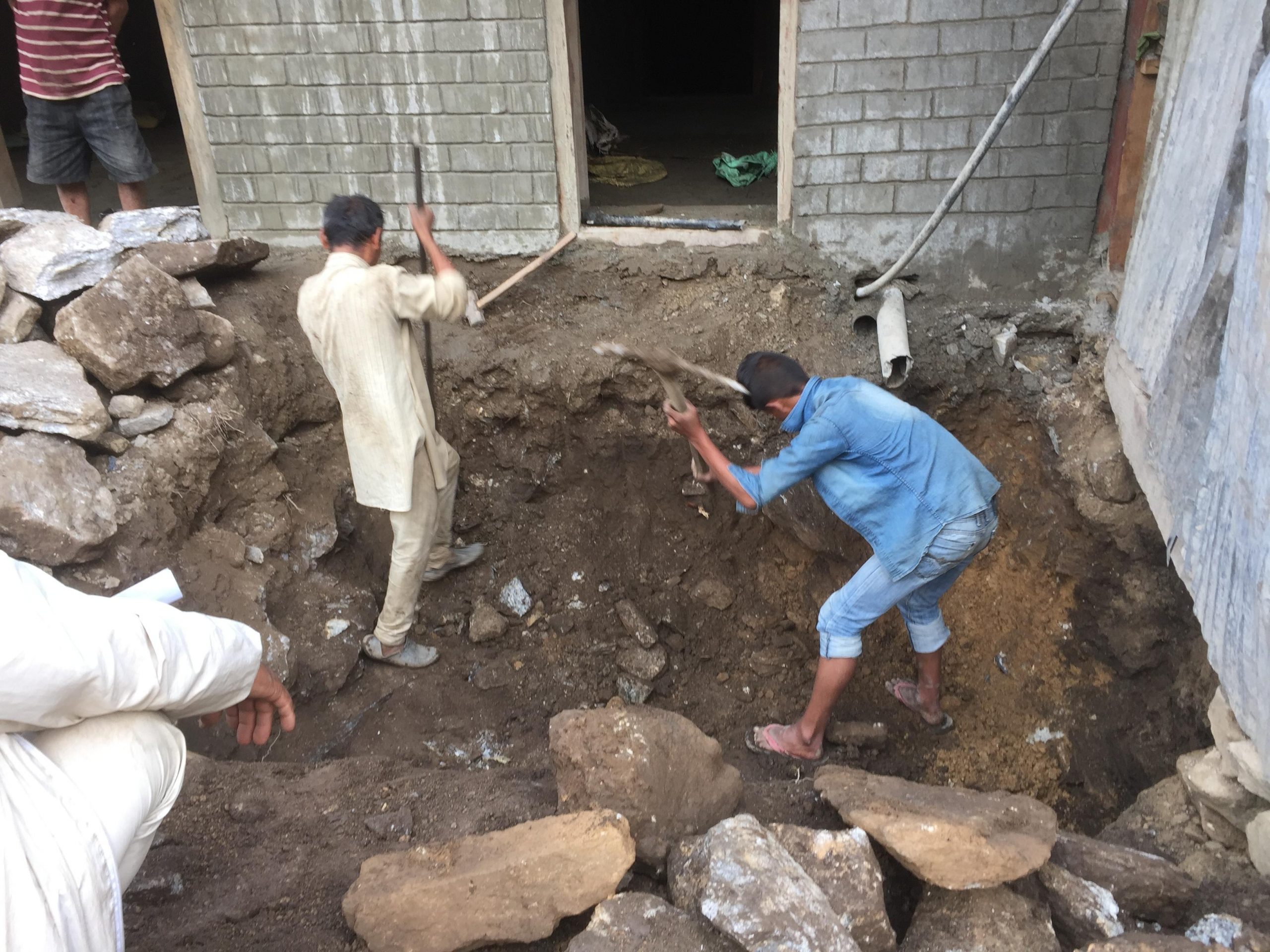 © Bina Limbu. Building a toilet with a septic tank is one of the mandatory criteria to qualify for the third and final tranche of the housing reconstruction grant. Many people had to demolish their old toilets, despite being functional, to build new ones, and many still used the old toilets and turned the new ones into storage, cattle-shed or for other purposes. © Bina Limbu. Building a toilet with a septic tank is one of the mandatory criteria to qualify for the third and final tranche of the housing reconstruction grant. Many people had to demolish their old toilets, despite being functional, to build new ones, and many still used the old toilets and turned the new ones into storage, cattle-shed or for other purposes. |
 © Bina Limbu. It was not only the houses and buildings that got damaged during the 2015 earthquake, but religious sites where people would offer sacrifices and prayers as well. While major temples in the Kathmandu Valley are slowly being rebuilt (many of which are funded by outside donations), many of the damaged temples in rural areas will need to be rebuilt by the local themselves. © Bina Limbu. It was not only the houses and buildings that got damaged during the 2015 earthquake, but religious sites where people would offer sacrifices and prayers as well. While major temples in the Kathmandu Valley are slowly being rebuilt (many of which are funded by outside donations), many of the damaged temples in rural areas will need to be rebuilt by the local themselves. |
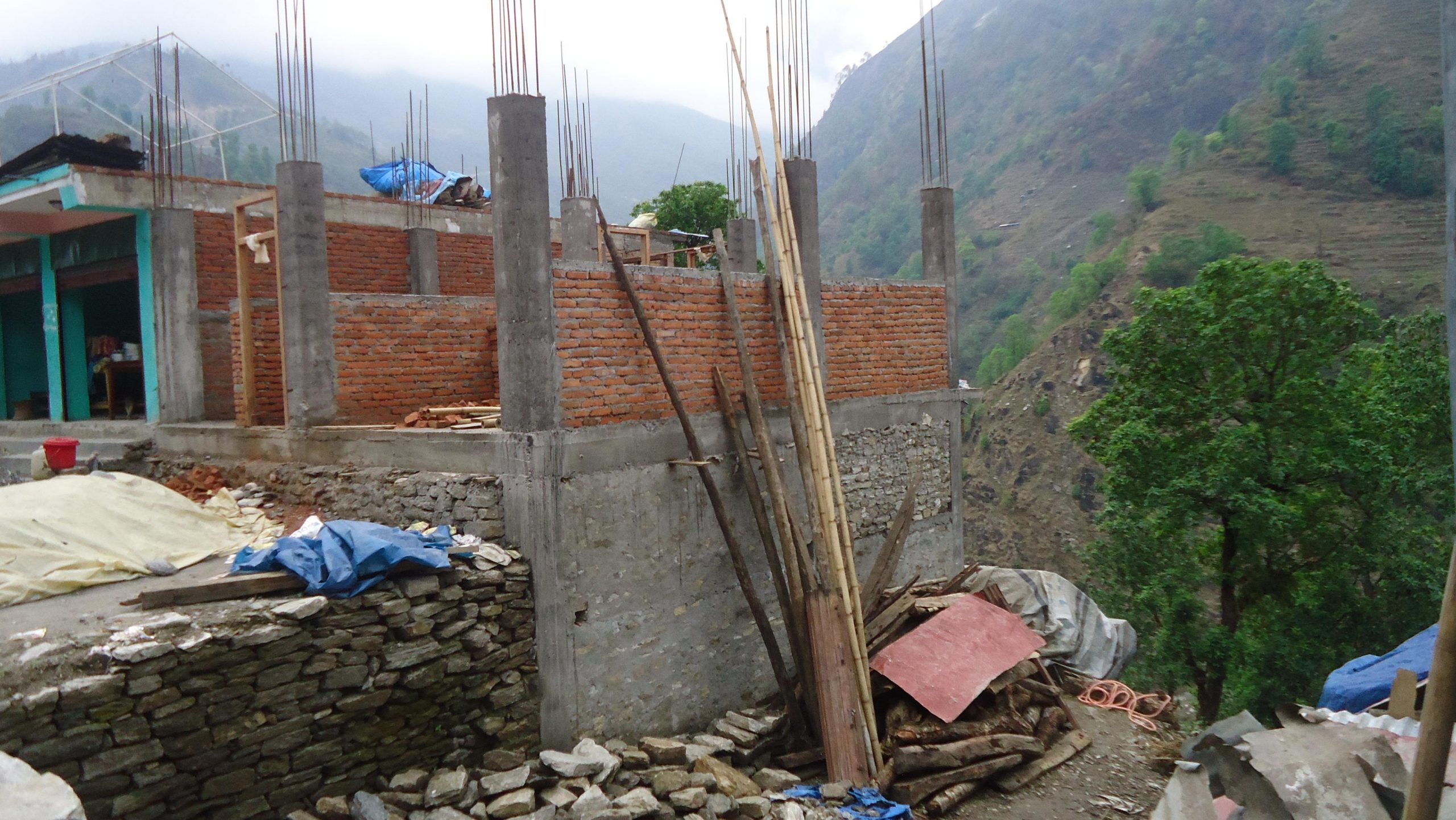 © Manoj Suji. Reinforced concrete has become a popular construction material in rural areas, replacing traditional mud mortar buildings. However, this also raises the cost of construction and sometimes the manpower needed to work with these new materials, as it has to be brought in from outside rural areas. © Manoj Suji. Reinforced concrete has become a popular construction material in rural areas, replacing traditional mud mortar buildings. However, this also raises the cost of construction and sometimes the manpower needed to work with these new materials, as it has to be brought in from outside rural areas. |
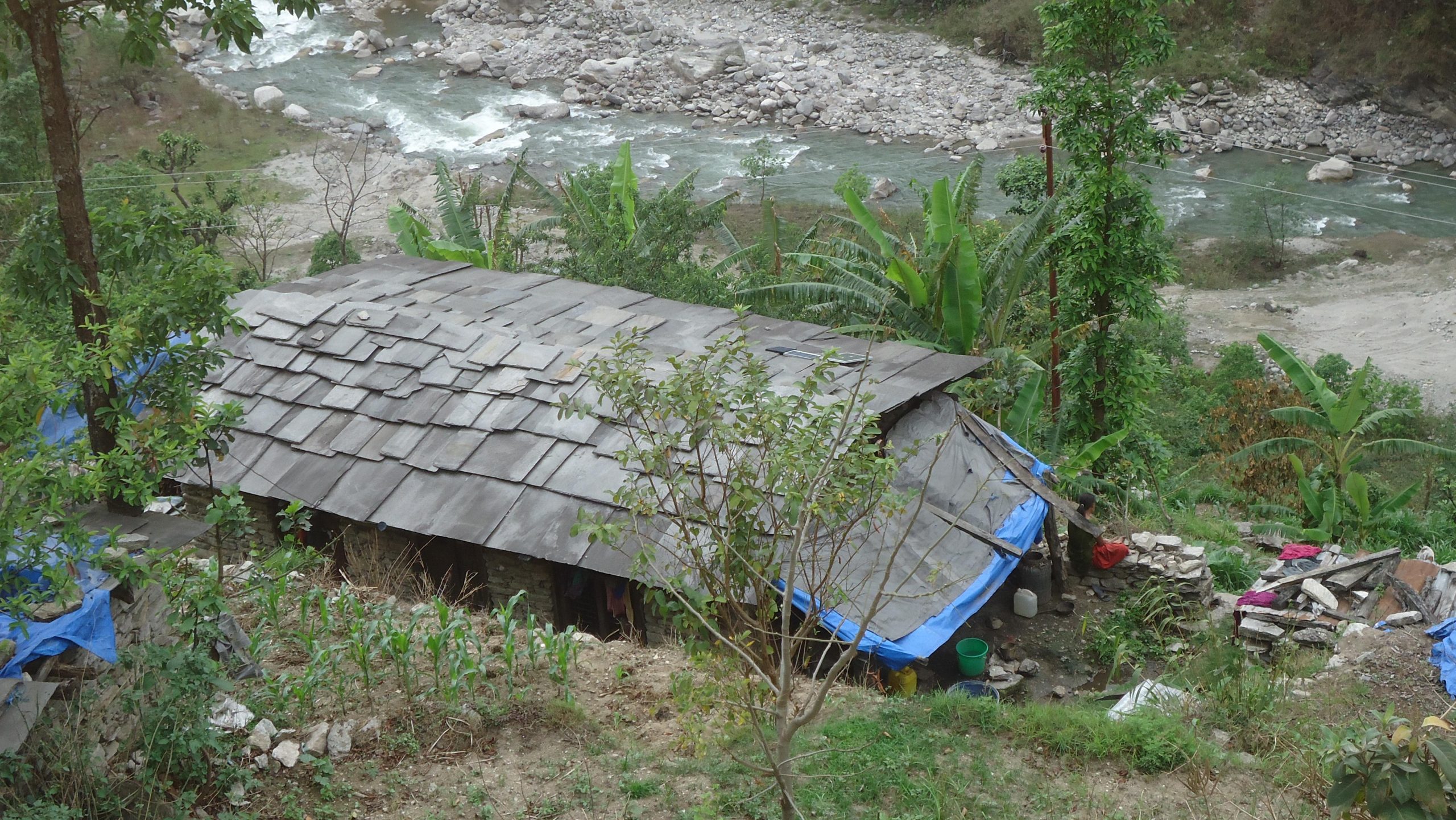 © Manoj Suji. Slates are easily accessible and are used extensively as roofing material. The owner of this house has attached a shed next to one of the walls for his animals. © Manoj Suji. Slates are easily accessible and are used extensively as roofing material. The owner of this house has attached a shed next to one of the walls for his animals. |
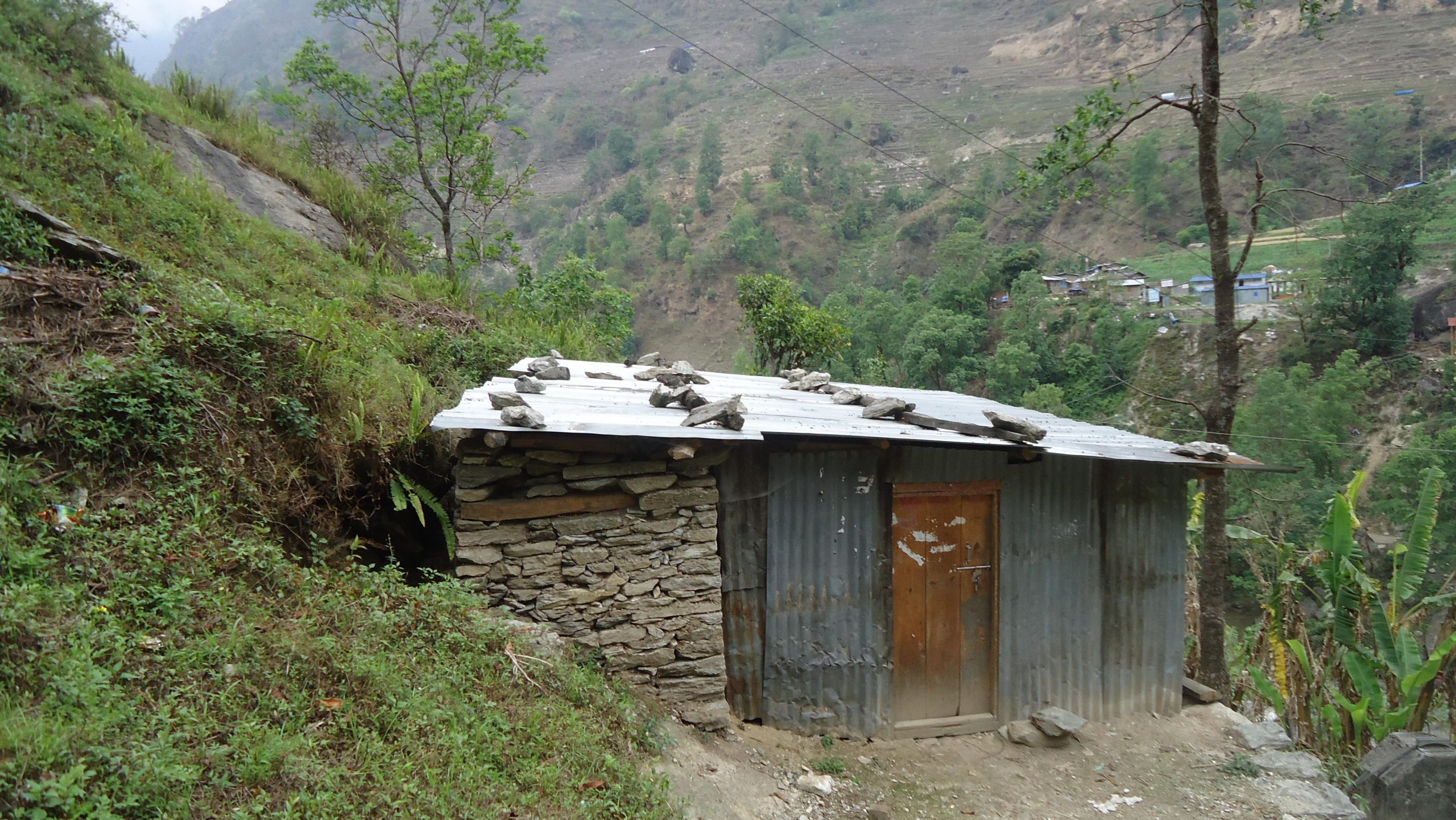 © Manoj Suji. The post 2015 earthquake reconstruction programme has not reached the most needy who have not been able to access the house grants for a variety reasons. Some of those reasons might include the lack of a land ownership certificate, one of the requirements for receiving grants, or having been missed in the damage survey or documentation by the government. This has been compounded by the poverty of these families, which made many of them landless in the first place. © Manoj Suji. The post 2015 earthquake reconstruction programme has not reached the most needy who have not been able to access the house grants for a variety reasons. Some of those reasons might include the lack of a land ownership certificate, one of the requirements for receiving grants, or having been missed in the damage survey or documentation by the government. This has been compounded by the poverty of these families, which made many of them landless in the first place. |
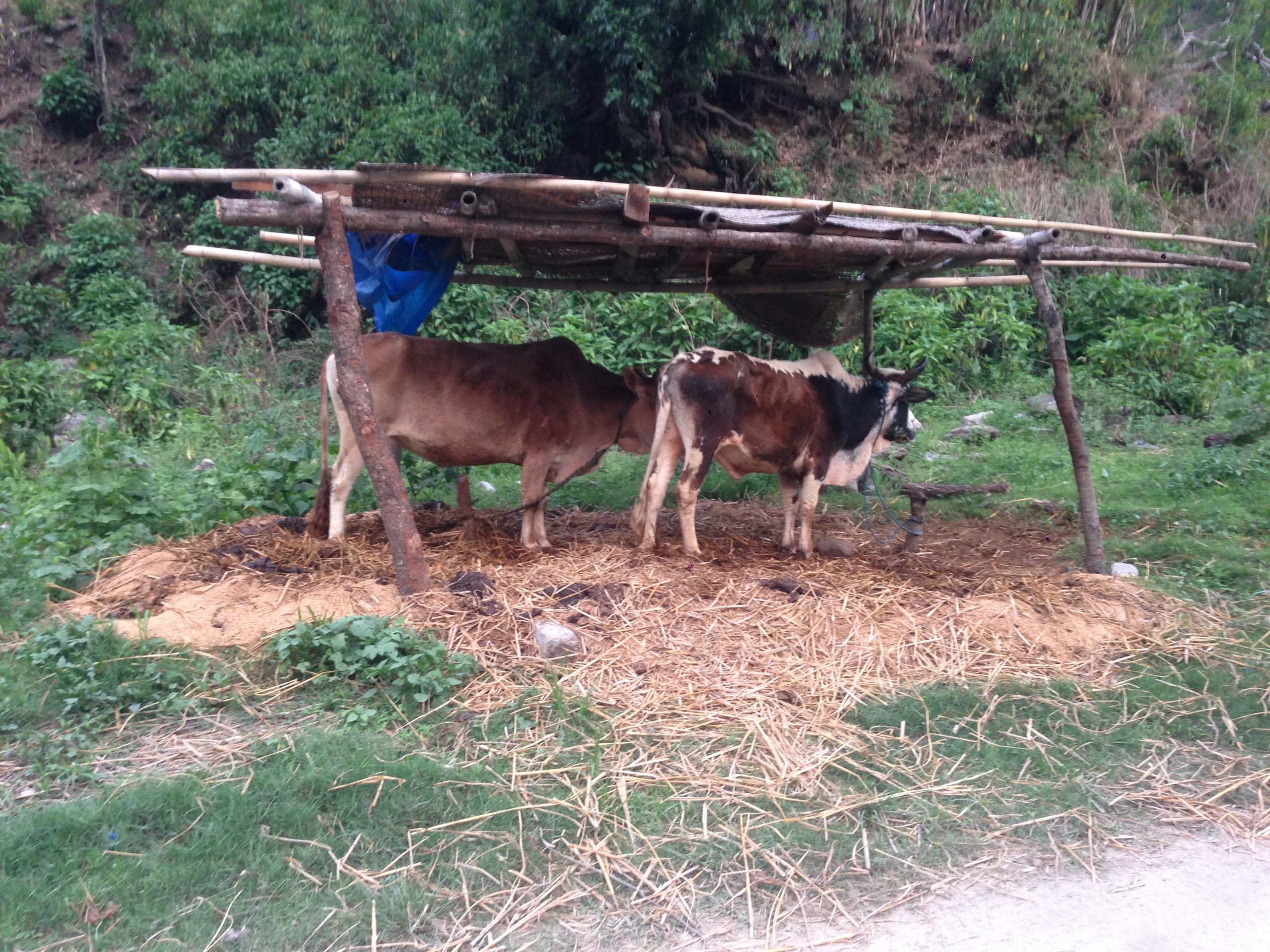 © Prakash Chandra Subedi. In rural Nepal, the households consist of subsistence farmers and animals are reared for their milk, meat, and fertiliser, as well as draught animals. In the earthquake, it was not only people that were displaced, but also animals. While the government is providing grants for housing in the aftermath of the 2015 earthquake, there is nothing for reconstructing animal sheds or other domestic structures such as granaries or wood sheds. © Prakash Chandra Subedi. In rural Nepal, the households consist of subsistence farmers and animals are reared for their milk, meat, and fertiliser, as well as draught animals. In the earthquake, it was not only people that were displaced, but also animals. While the government is providing grants for housing in the aftermath of the 2015 earthquake, there is nothing for reconstructing animal sheds or other domestic structures such as granaries or wood sheds. |
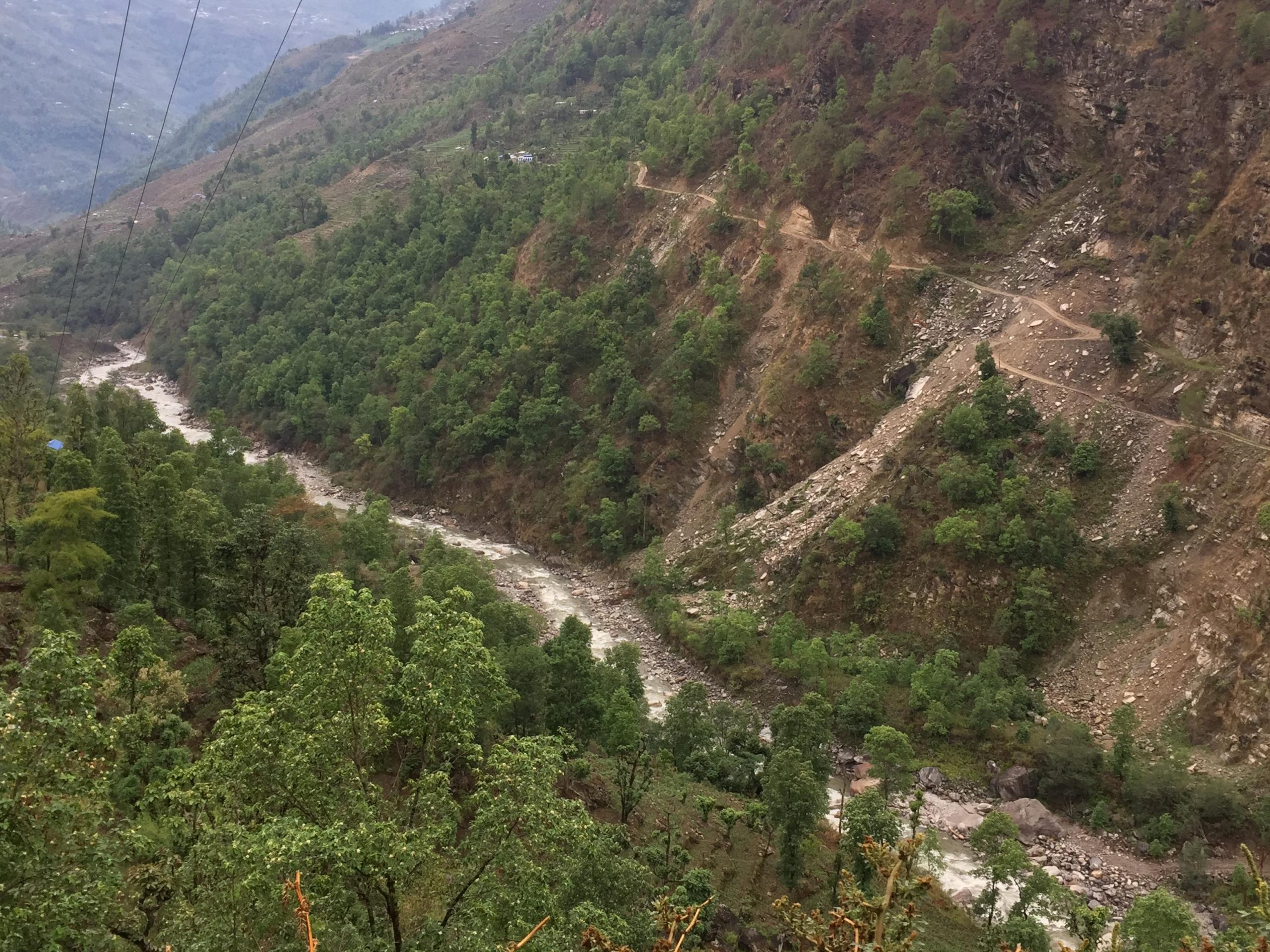 © Bina Limbu. Following the 2015 earthquake, the importance of access was shown during the rescue and relief efforts, as well as during the reconstruction period. Roads are being constructed all over the hills, sometimes with catastrophic results as the roads pass through fragile terrain. © Bina Limbu. Following the 2015 earthquake, the importance of access was shown during the rescue and relief efforts, as well as during the reconstruction period. Roads are being constructed all over the hills, sometimes with catastrophic results as the roads pass through fragile terrain. |
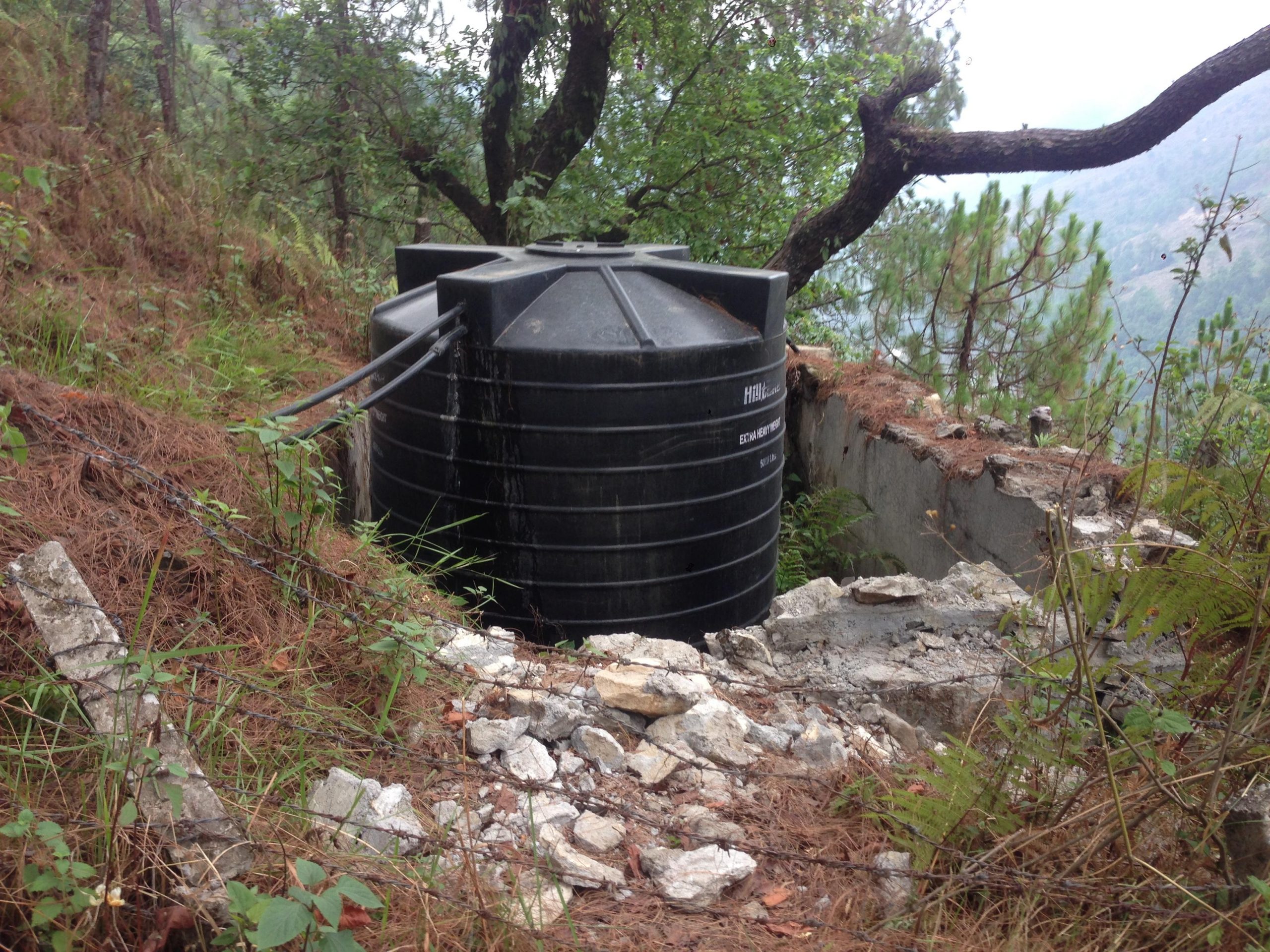 © Prakash Chandra Subedi. The old cement-mortar water distribution tank has cracked during the 2015 earthquake and has been replaced with a small, but easier-to-install plastic tank. © Prakash Chandra Subedi. The old cement-mortar water distribution tank has cracked during the 2015 earthquake and has been replaced with a small, but easier-to-install plastic tank. |

